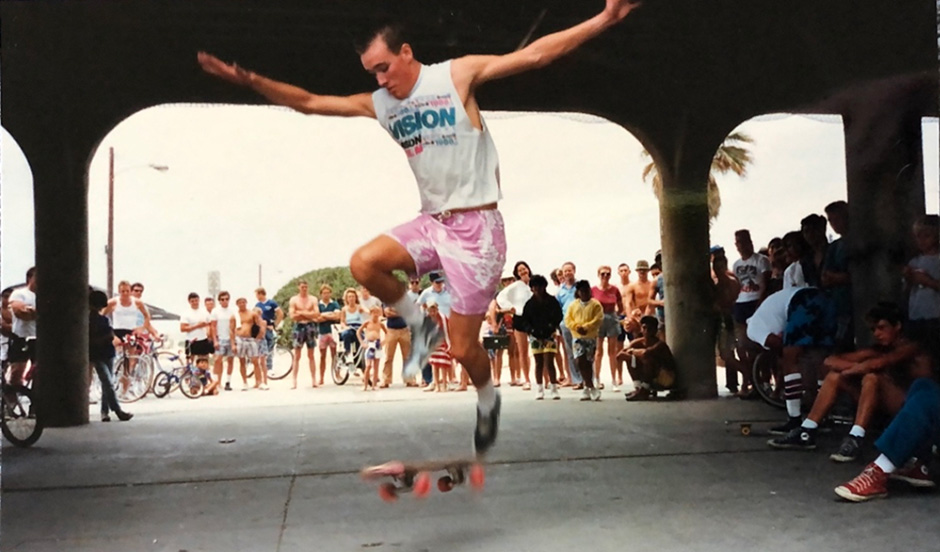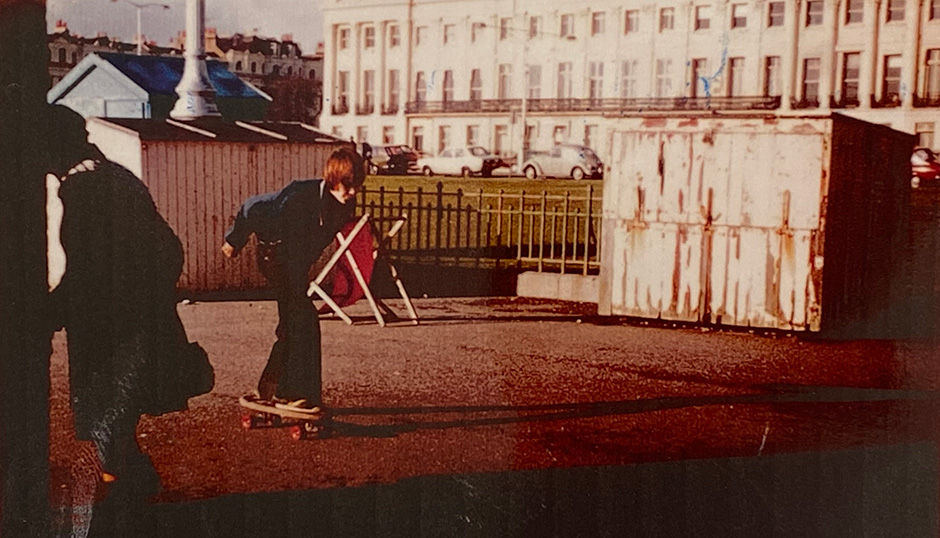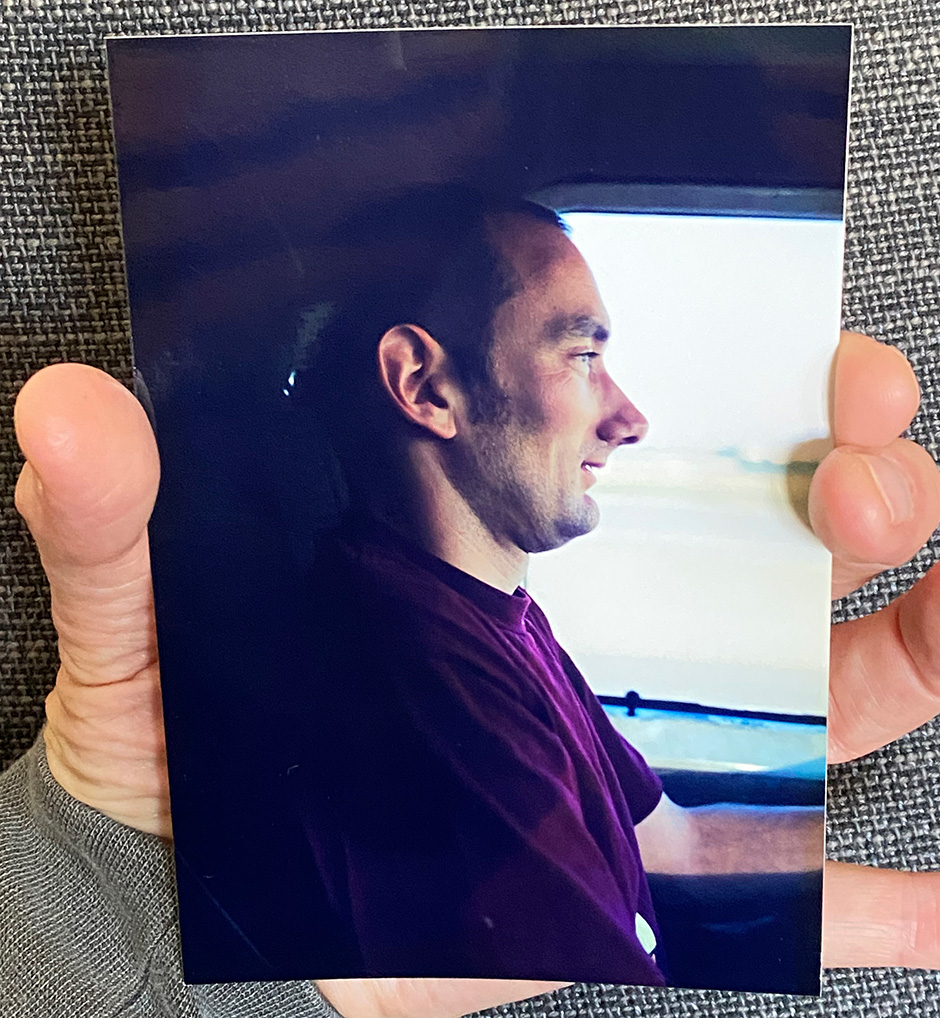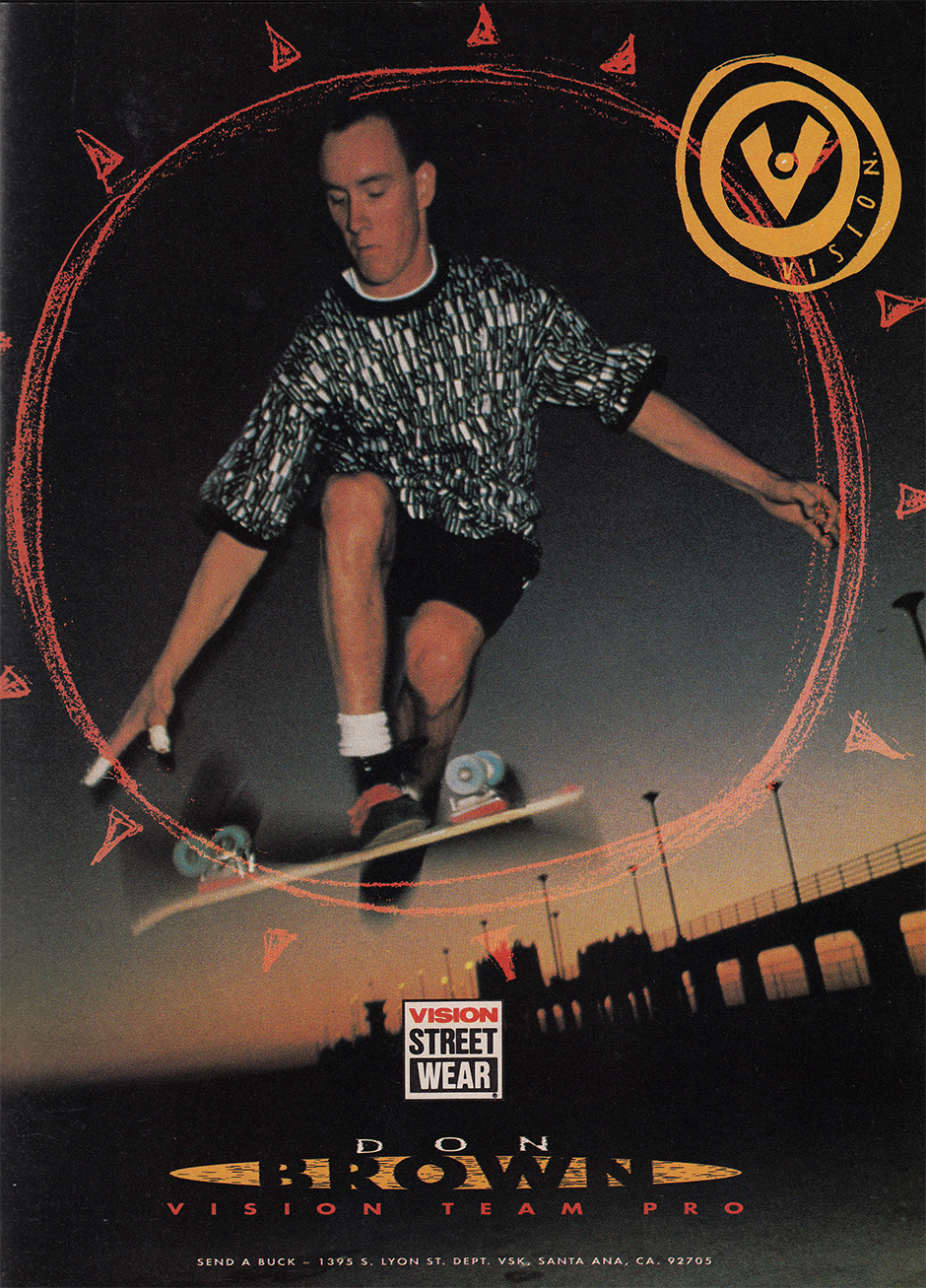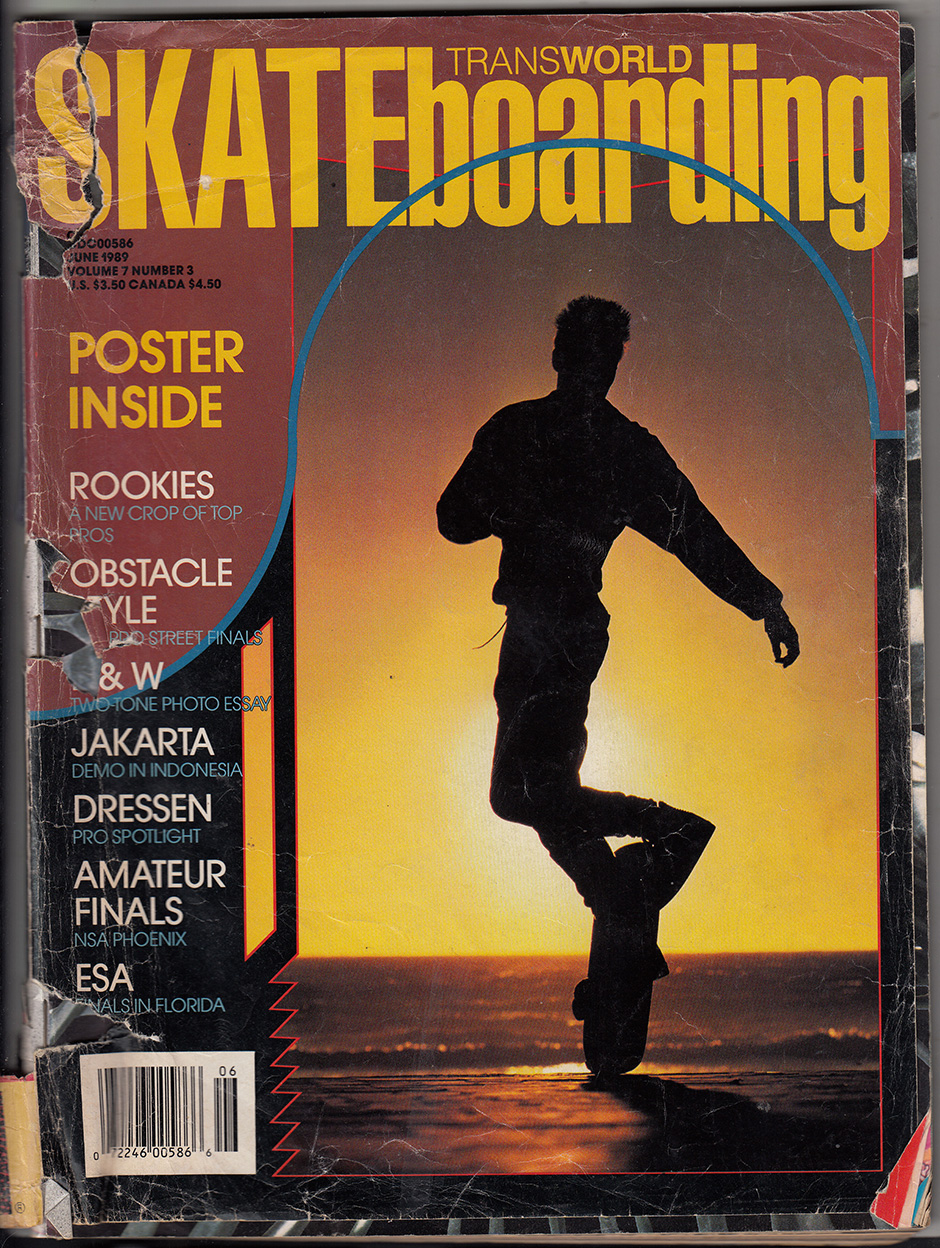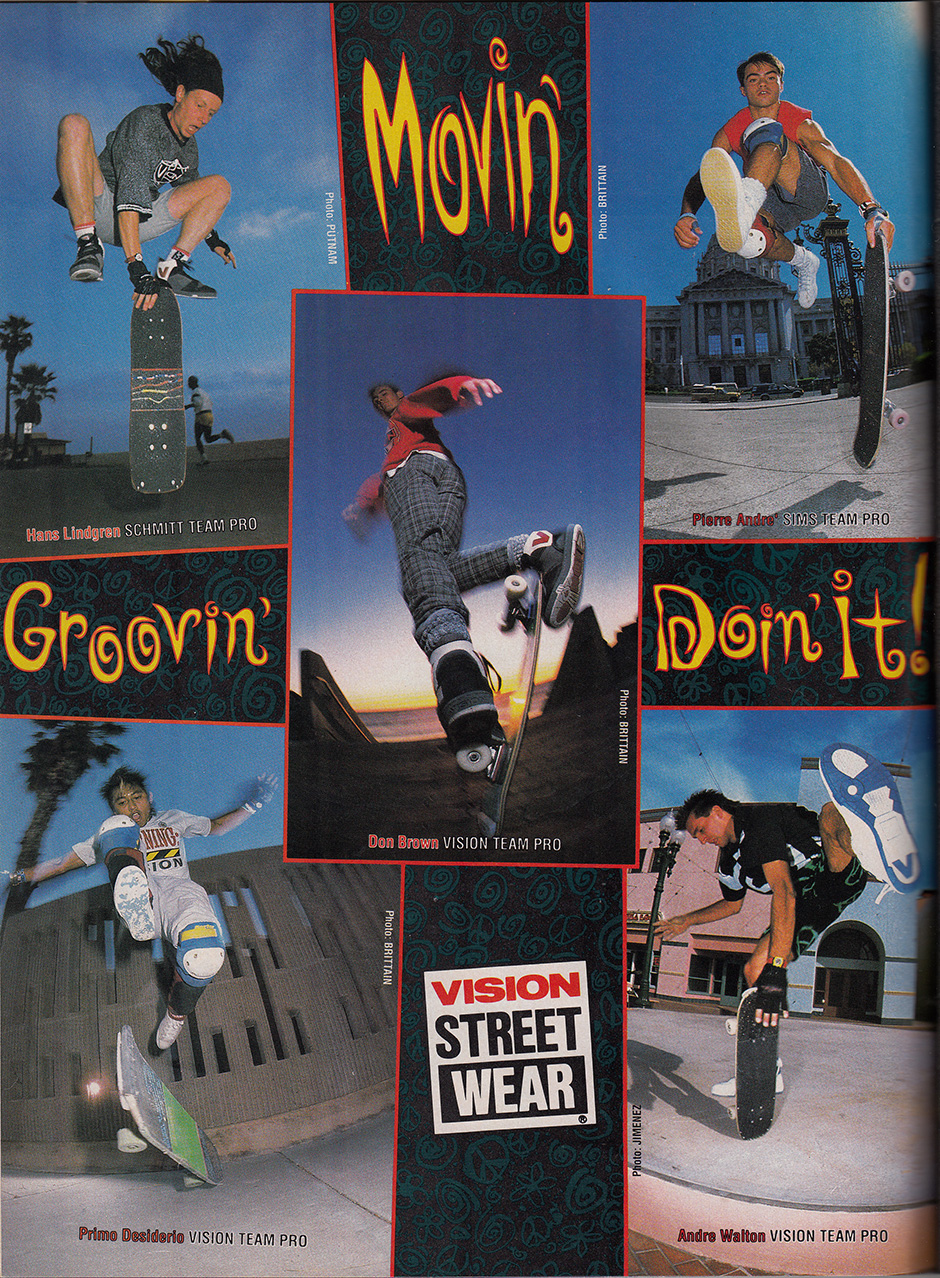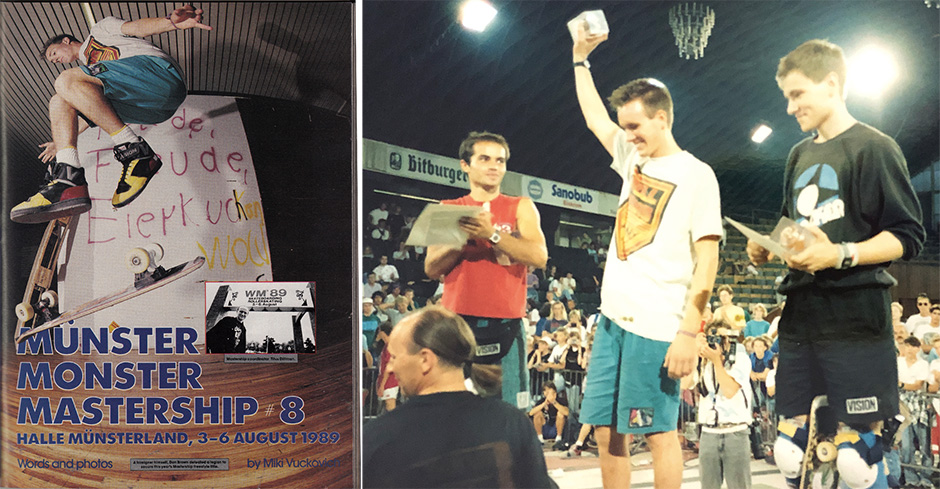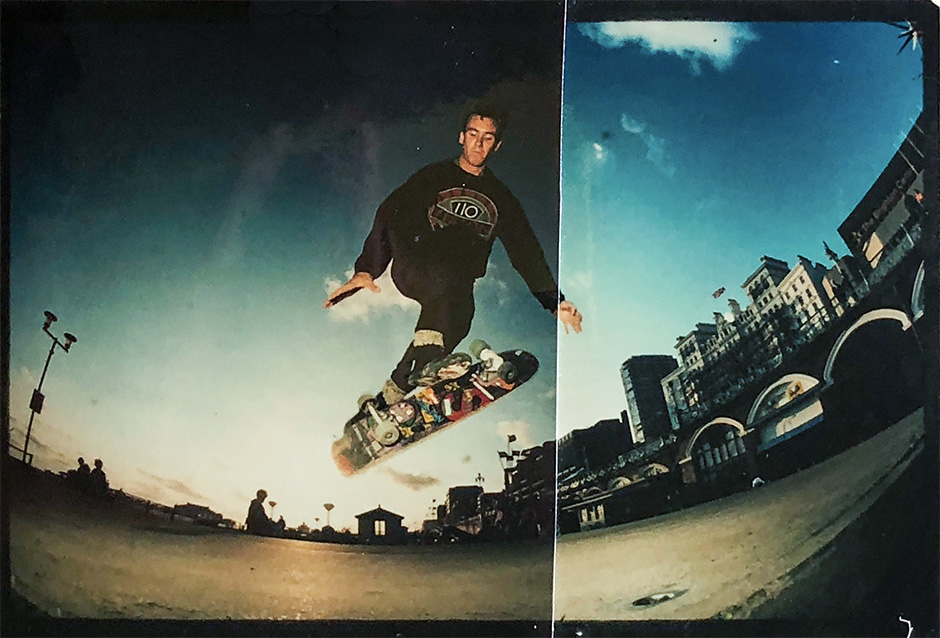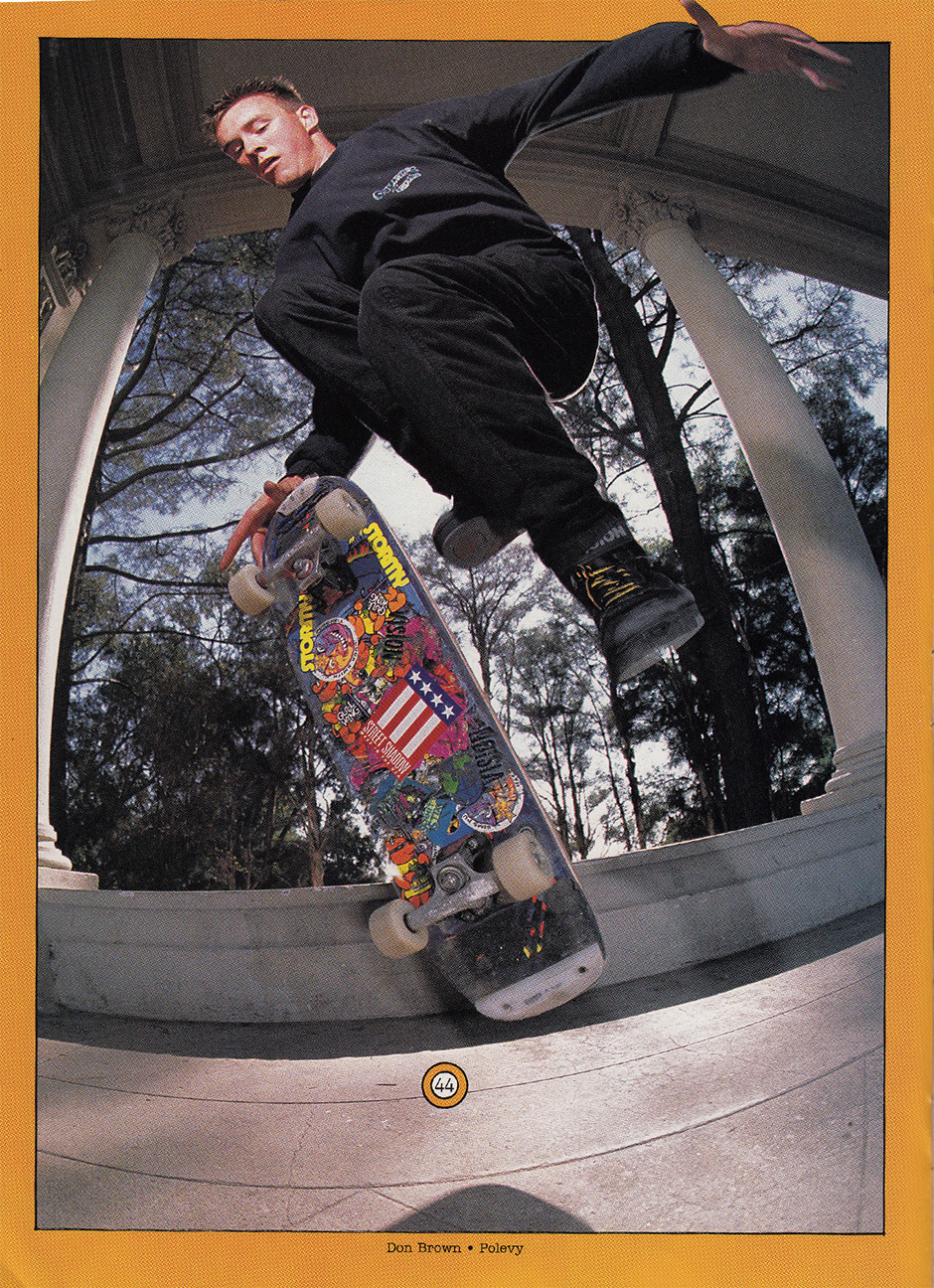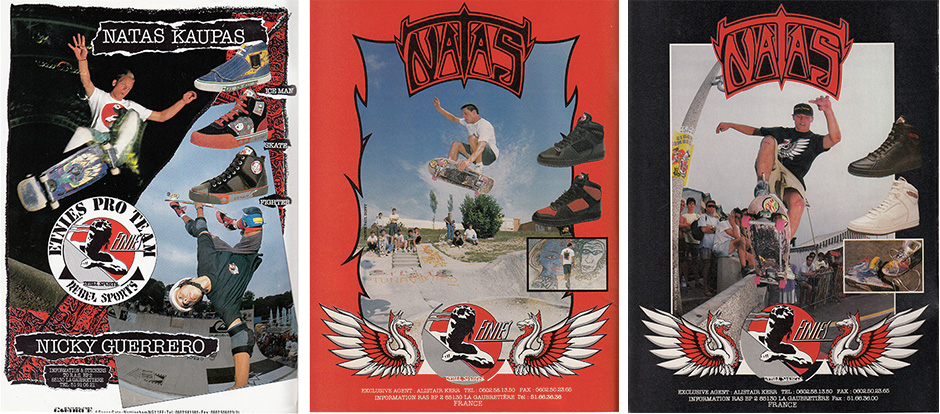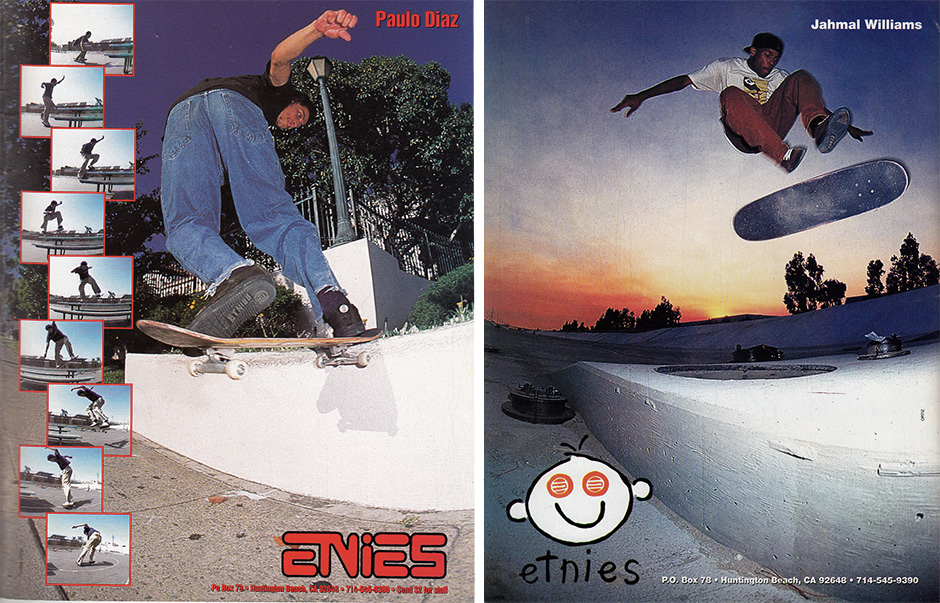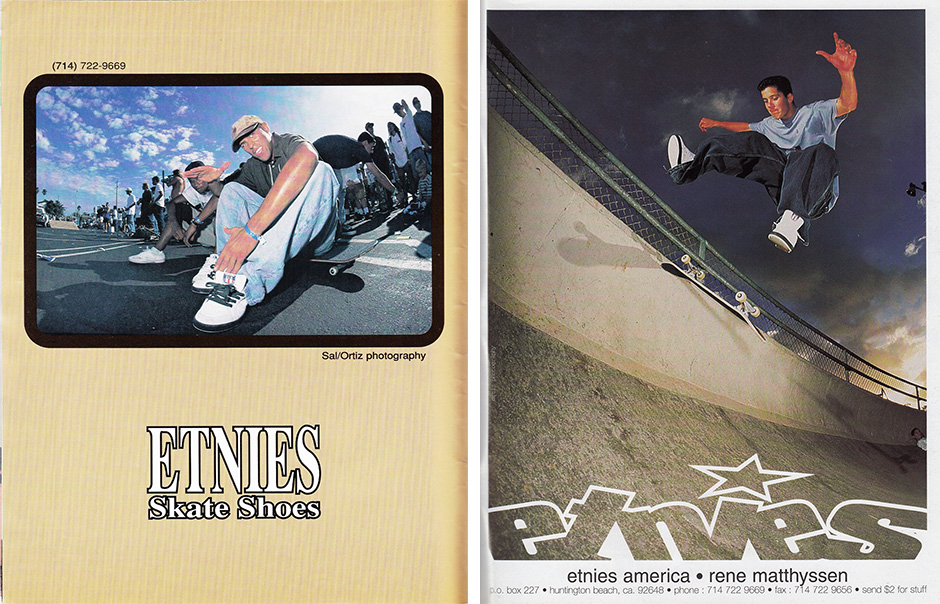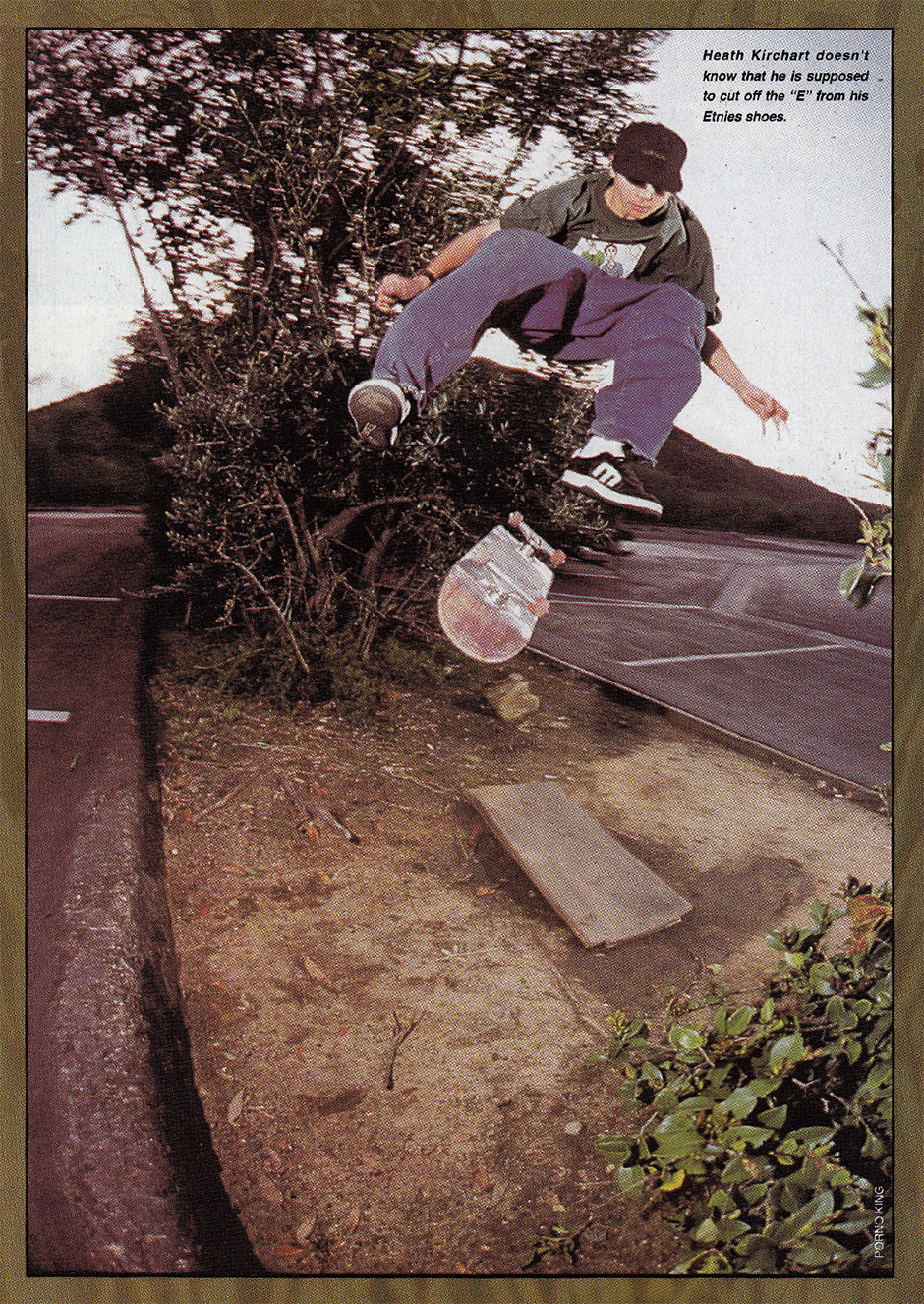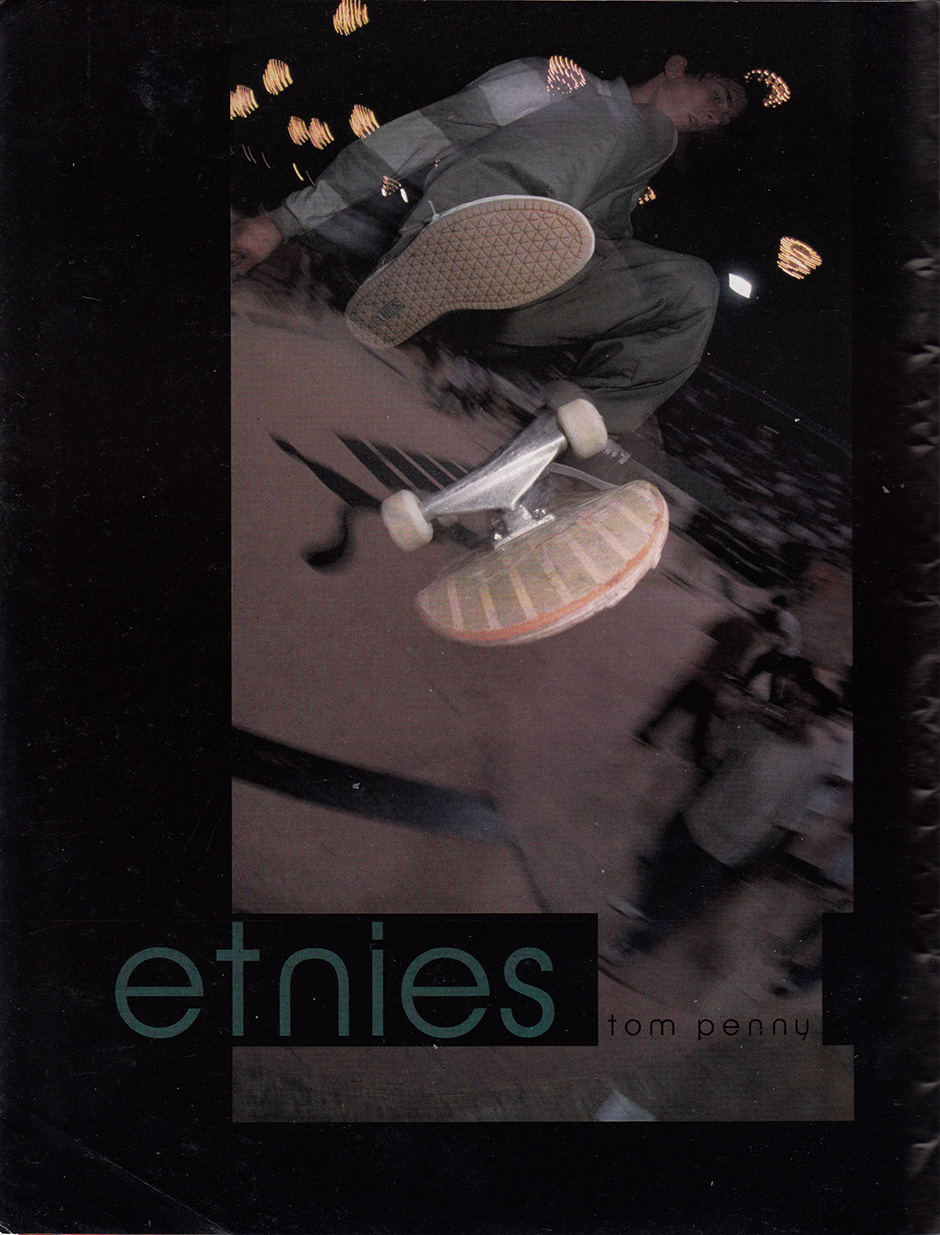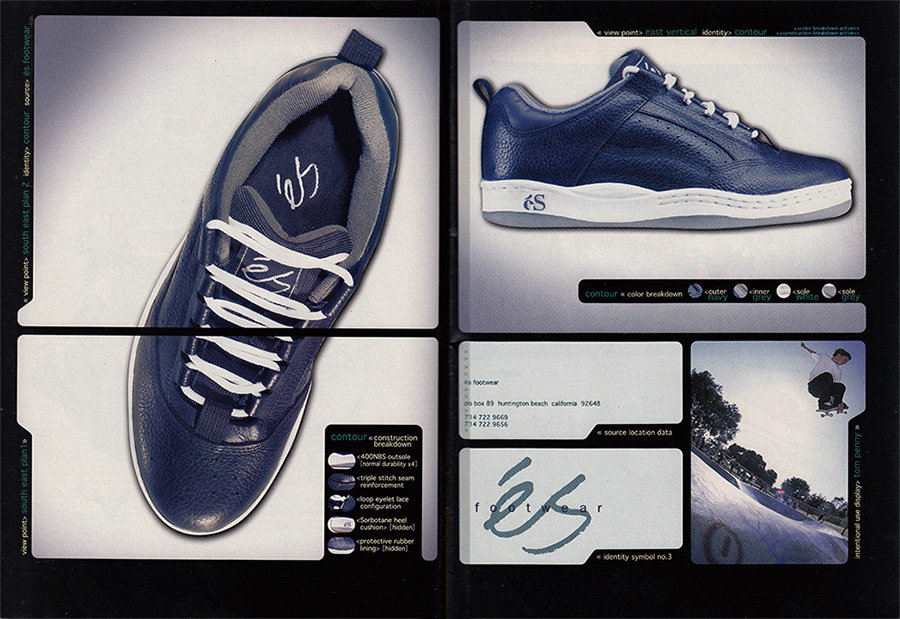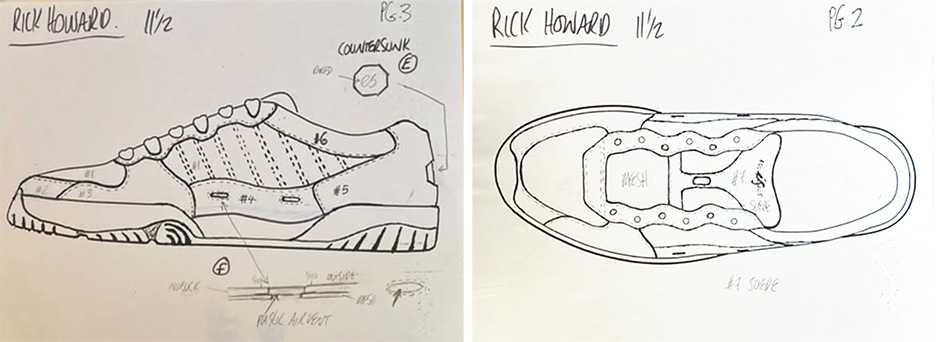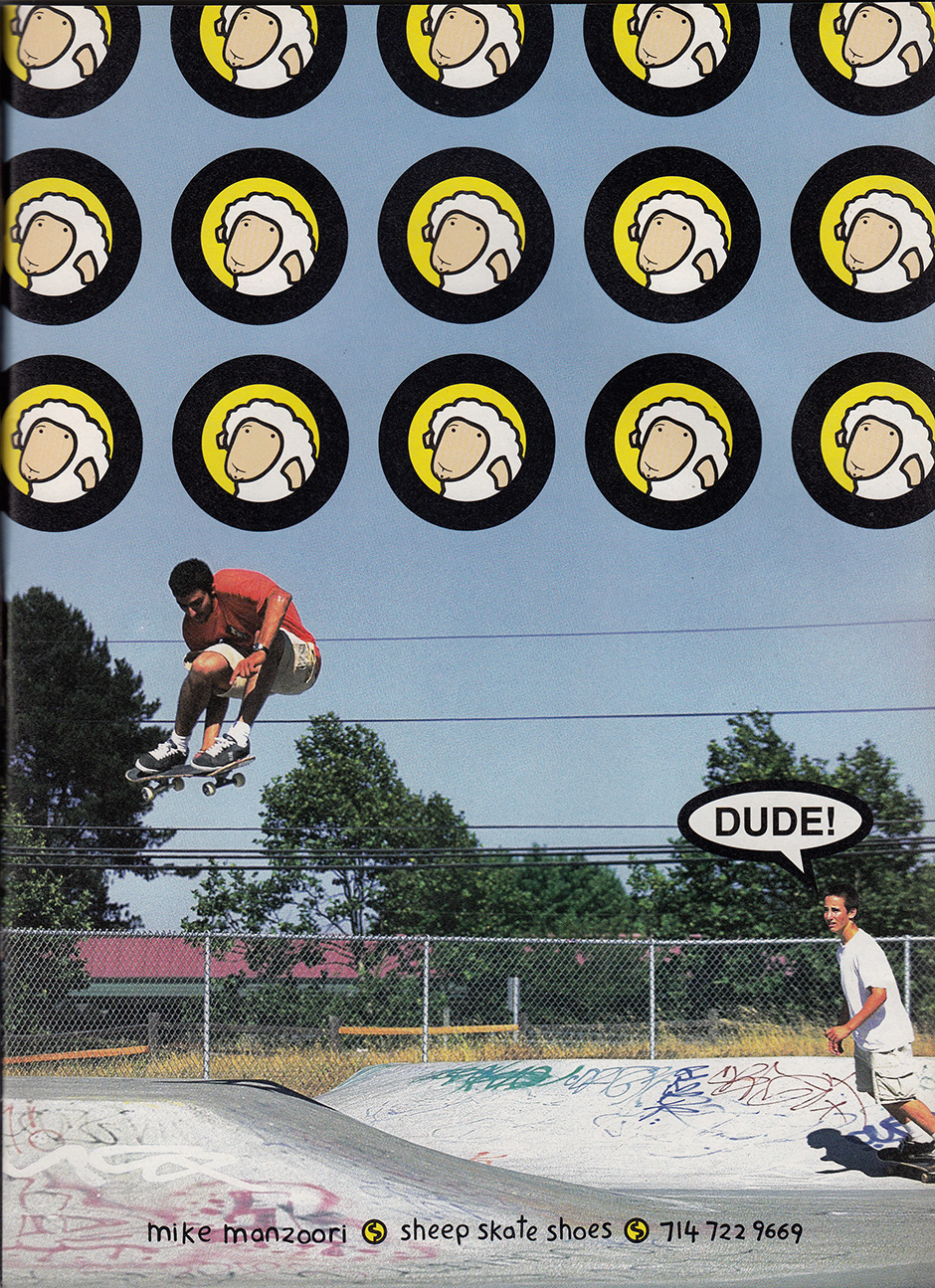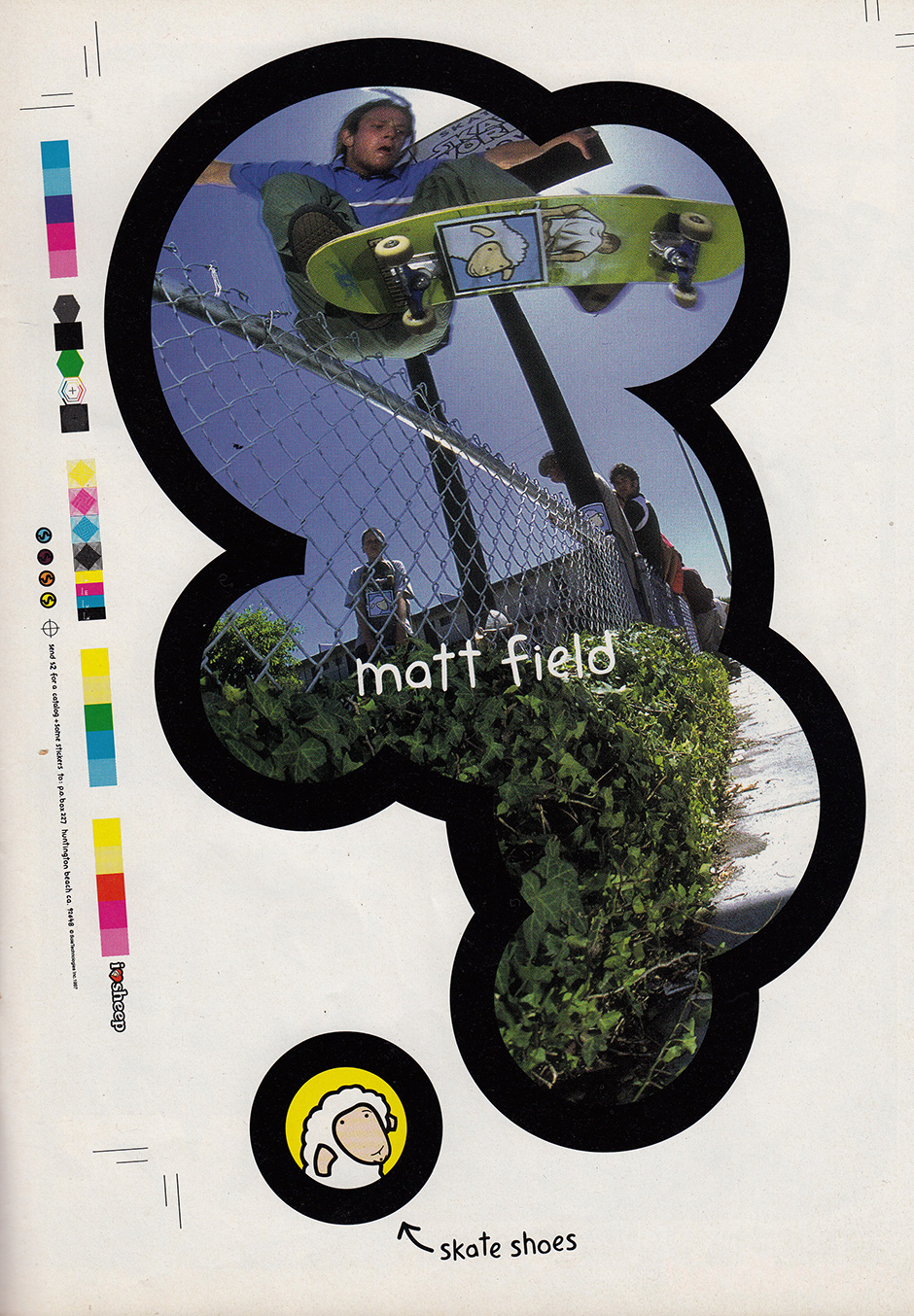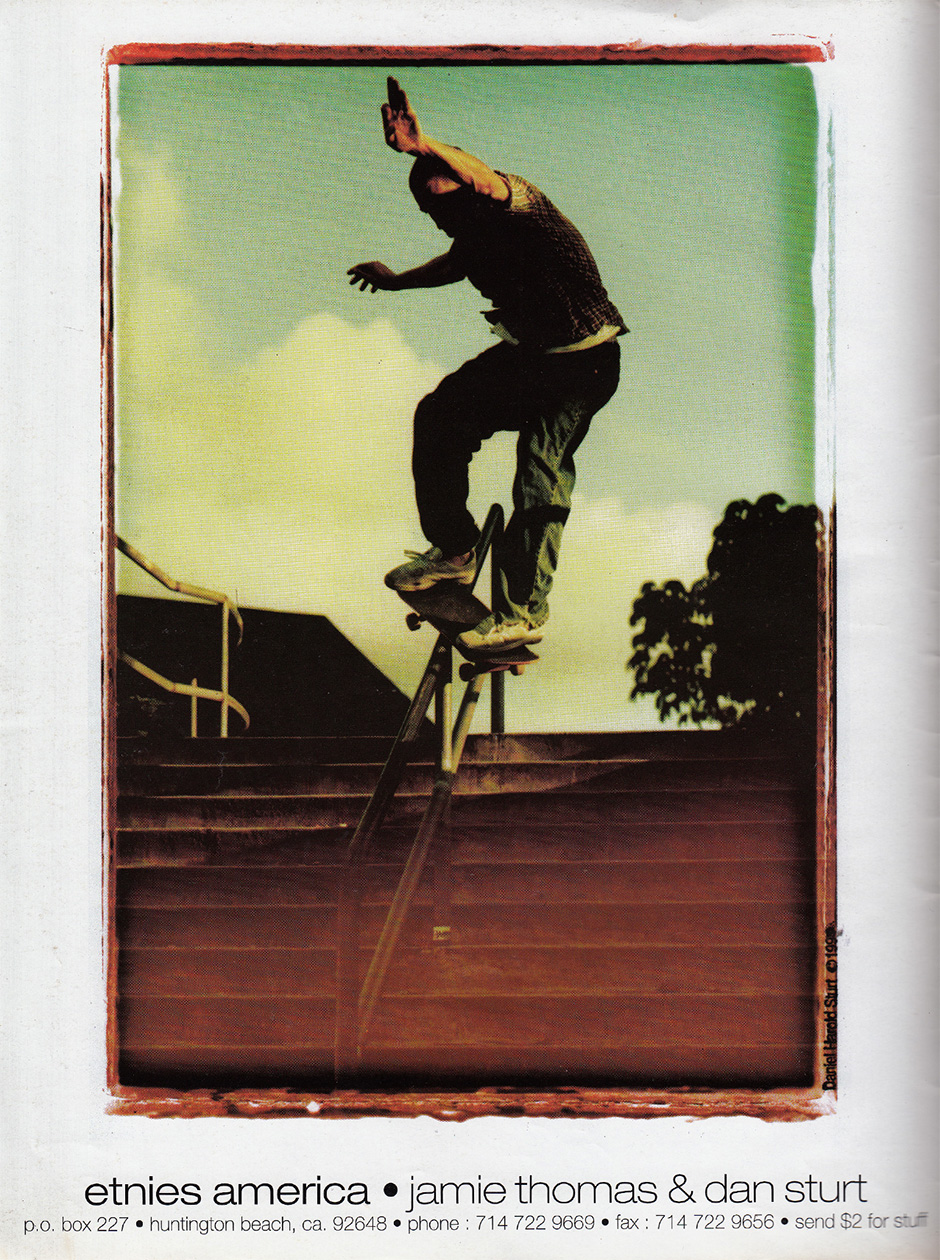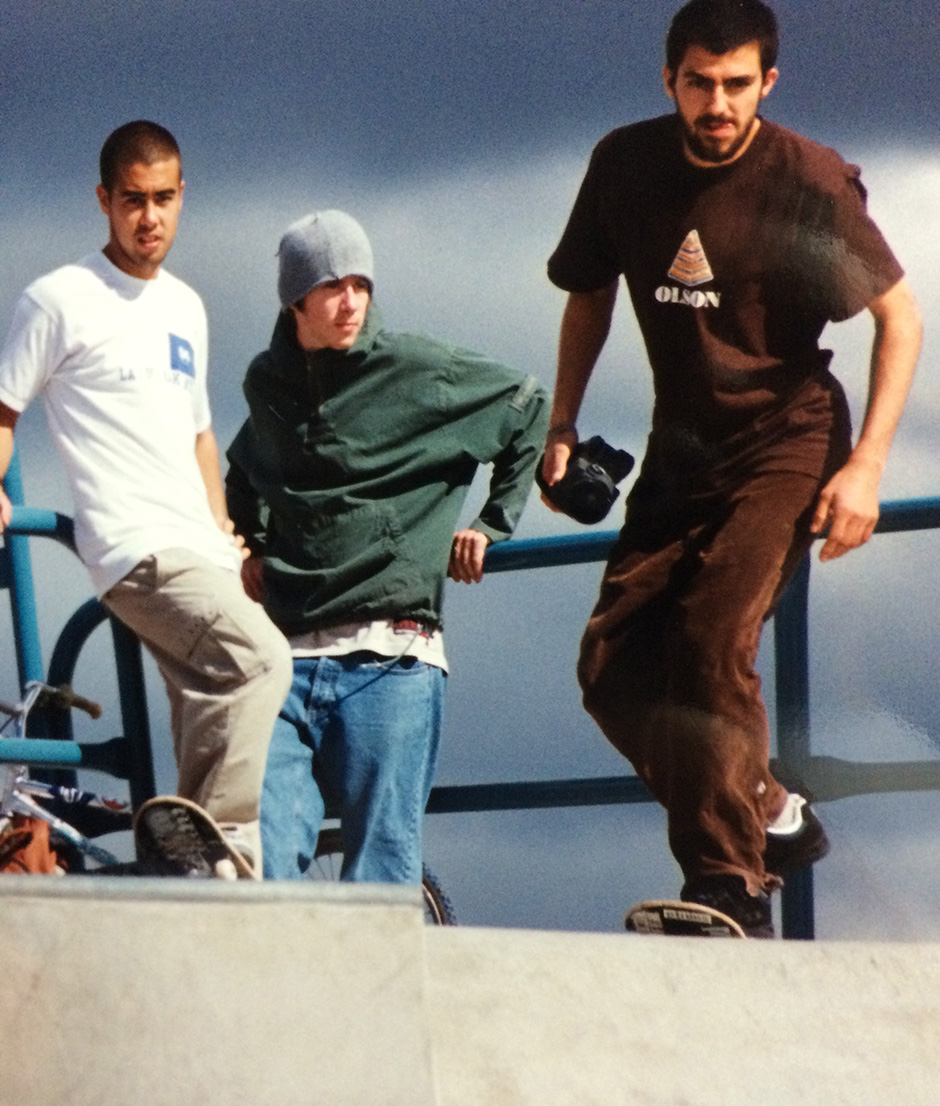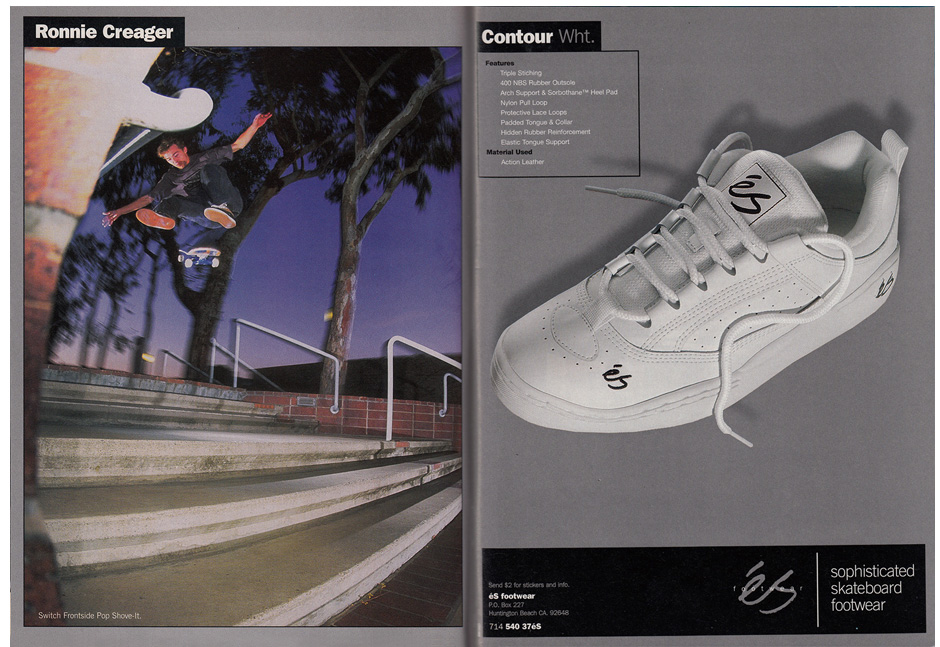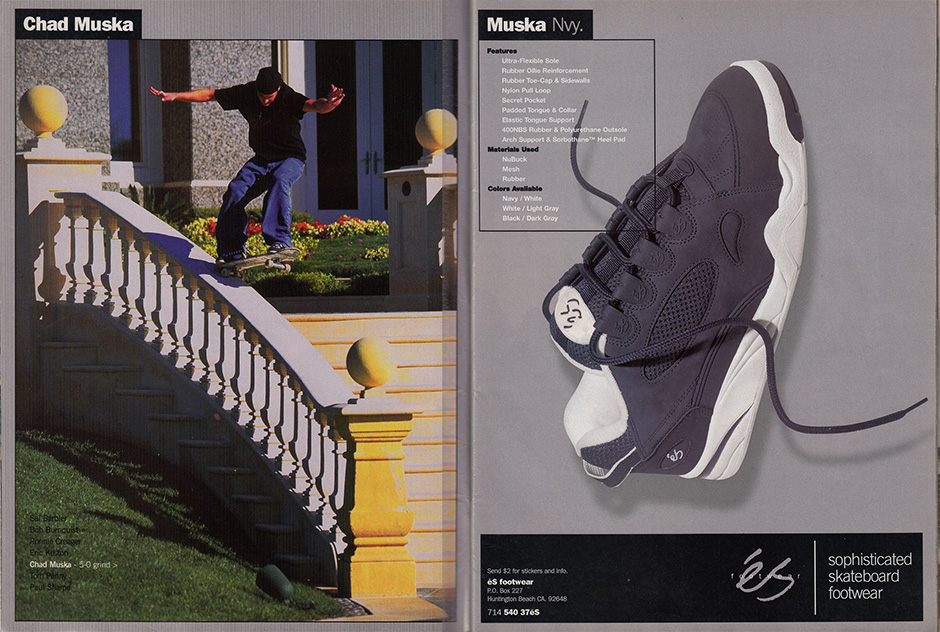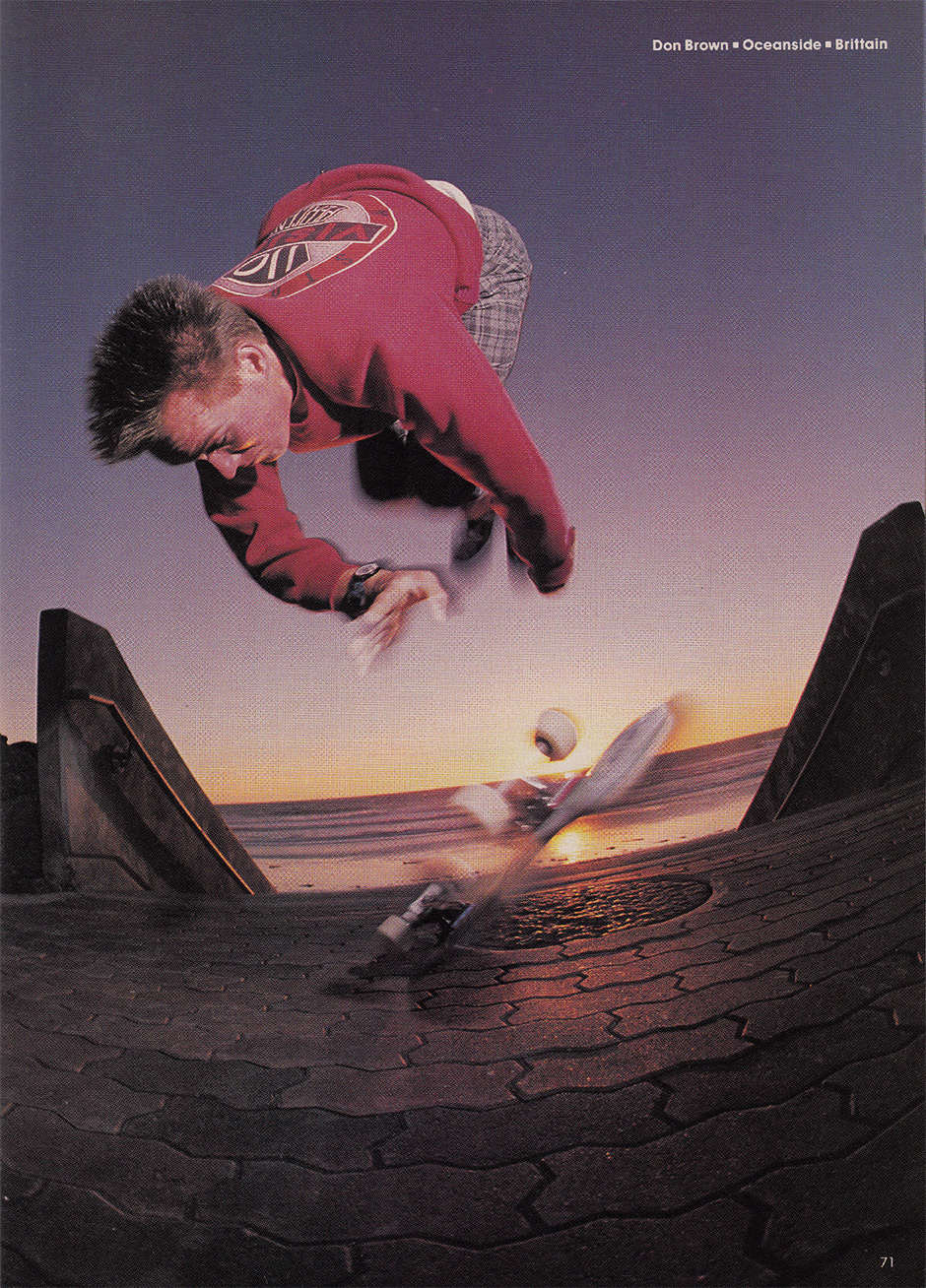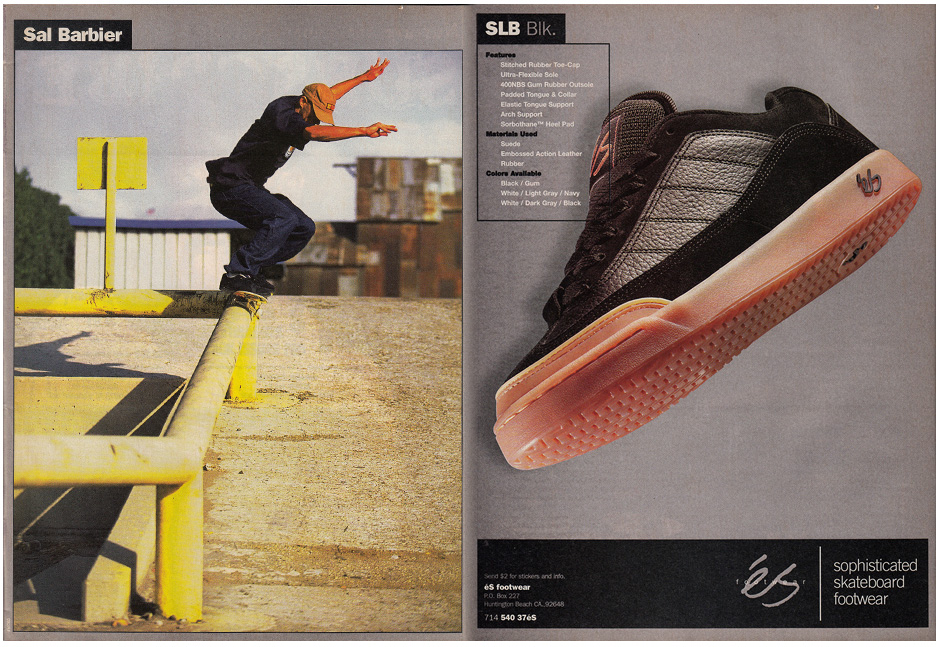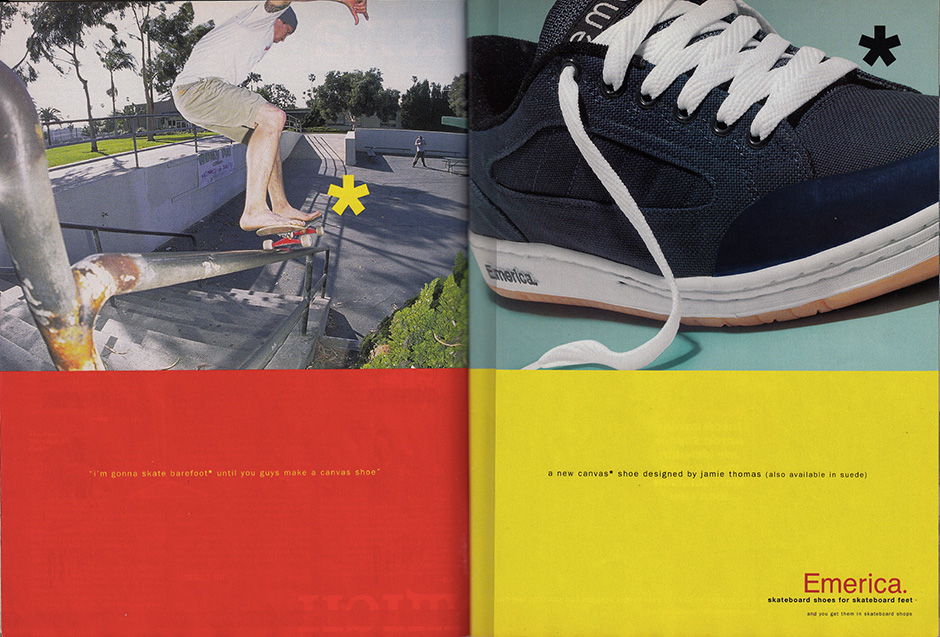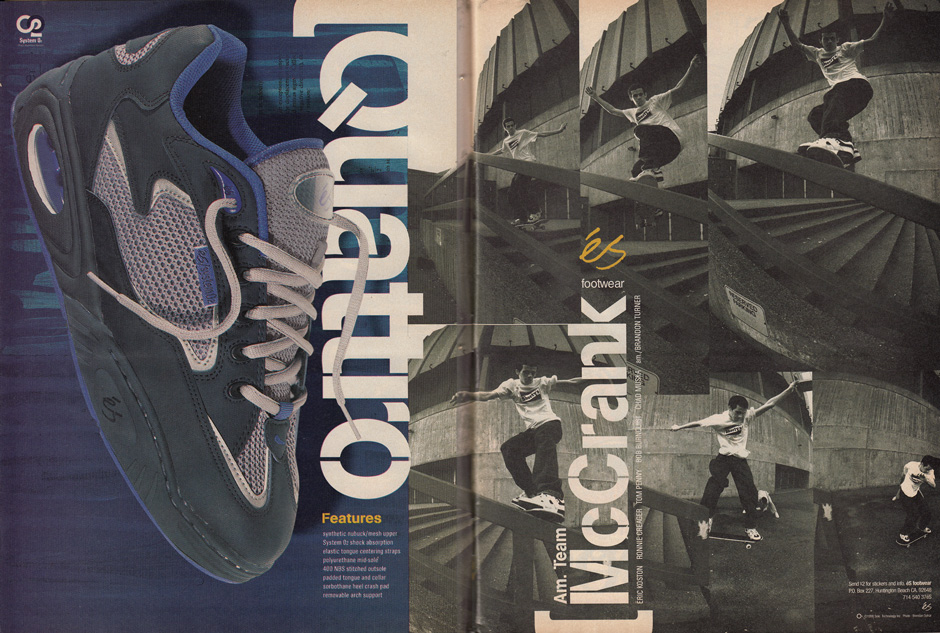Interview by Neil MacDonald (@SCIENCEVERSUSLIFE). Self portrait by Don Brown.
From borrowed boards on Brighton seafront to Huntington Beach and shaping one of the biggest and most important skate shoe companies ever, Sole Technology’s Don Brown has been around for most of the significant changes in modern skateboarding over the last thirty years, and it’s definitely fair to say that he had a hand in shaping a few of them.
Typical of an innovator, Don says that much of his life is down to chance, a result of being in the right place at the right time, but as always, those places and times are only ever recognised years later. It’s not necessarily the case that Don was lucky to be where he was when he was, it just makes sense that the relationships he made with people through riding a skateboard would be the ones that ultimately took him to the position he’s in now. A need to be constantly skateboarding led to his “unintentional” pro sponsorship, and helping out a freestyler mate led him to his central role at Sole Tech and eventually the responsibility of reshaping etnies for the nineties streetskating revolution and introducing the tech of éS, the Hollywood High hesh of Emerica and Sheep’s vaguely vegetarian anti-marketing to the same retail landscape, creating those brand identities, building those teams and designing those shoes.
Some of skateboarding’s most iconic shoes, ads and video parts followed, and Don put together some of the heaviest teams ever seen.
The love of riding a skateboard, a group of friends and a one-way ticket to the US changed Don’s life before he’d even turned 20. Don had a pro board on Vision when that company was peaking with its stadium-touring superstar dream-team, and he witnessed the almost-overnight crash when Vision and their corporate contemporaries crashed out of the marketplace and allowed teenage skateboarders–with the help of Steve Rocco–to completely reshape the marketplace. The bloated corporate version of skateboarding, distorted beyond recognition by money, greed and fluorescent lycra shorts finally succumbed to its own ego and imploded, leaving non-skating businessmen with warehouses full of unwanted stock as the new generation lathed their wheels, hacked their high-tops into lows, sanded off graphics, filmed entire video parts on supermarket kerbs and actually felt like skateboarding belonged to skateboarders again. Because it did.
Unlike the other skateboard shoe companies of the time, etnies was able to adapt and make the skate shoes that skateboarders actually wanted, with the corporation-baiting logos and ads that exemplified the direction skateboarding was going in. etnies knew what they were doing because they were skateboarders themselves, and they listened to what other skateboarders actually wanted–something that’s still true today, more than thirty years on from etnies’ Natas Kaupas model, the first pro model skateboard shoe.
Don’s been around–and worked with–some of the most important people in skateboarding since his teens, and his life has been hugely shaped by both the act and the business of skateboarding, so he’s obviously got some stories to tell. I called him up to find out his…
Don localising Huntington Beach Pier in 1986. A conversation here would change his life course
What does a Chief Brand Strategist do? I believe that’s your official title.
I just made that title up. So basically, the quick background is, I grew up skateboarding in the UK then came to the US on a one-way ticket and got unintentionally sponsored. I went through that whole eighties period of being an am and then turning pro, and skateboarding is normally on something of a ten-year cycle of boom-and-bust so it crashed at the end of the eighties as a new generation of skaters were coming through. I saw Pierre [-André Senizergues], my good friend who I’d skated with for many years, at the beach down in Huntington and he asked if I wanted to help him at etnies.
So, it was me and him—he had a business partner at the time, but he was pretty useless and not doing much for the company. We worked on building etnies up doing whatever it took. I worked on the marketing, sales, and shipping with a little bit of product design and a lot of team stuff, and we created other brands which eventually needed marketing managers. My role was VP Marketing for Sole Technology, overseeing the brand portfolio strategy and the brand’s marketing team and being somewhat the face of the company to the action sports community
Today I’m focussed mostly on éS and Emerica–which I helped to launch over 25 years ago–then involved with etnies on a bigger picture level. éS, was a brand that I was heavily involved in building from the beginning, in 1995, and building one for the best skate teams ever created and a brand that elevated the game. In 2012 based on industry conditions we had to put éS on hiatus. In 2014 we relaunched as demand and love for éS was so strong. For me this was a great opportunity to get back down in the trenches and relearn first-hand the new generation of skateboarders and how they interact with brands via Social Media… it was exciting as a marketer to be able to get first-hand insights from brand fans and give them what they want.
That’s what I love the most, being around skateboarders and skate retailers. It’s hard when you’re higher up in an organisation. I heard someone say that the higher up get in an organisation, the thinner the air gets… You get dizzy and out of touch when you’re too high up, but for me my passion is being in the mix on the front line. Being able to really get into it and see how skateboarding evolves, and how consumers evolve and be connected from the bottom to the top.
You probably need to have been there as long as you have to do that. To understand what the brands mean.
Exactly. I’ve kinda become the face of Sole Tech in that way, mostly with skateboarding but also with BMX, surfing, snowboarding. A lot of people in the skate community know me as Sole Tech as I’ve been on the front end while Pierre’s always focussed a little bit more on the back end, on the business side of things. So, it’s a good mix.
You’re known as a freestyler, which is pretty niche. What drew you to freestyle? And that’s something I’d want to ask any freestyler. Why didn’t you want to roll around?
There’s a couple of reasons for that. I first picked up a skateboard in 1976, this Surf Flyer that my brother had mysteriously found in a park… I’ve never known if he stole it off someone or if he really did just find it, but either way it somehow ended up in my hands.
I rolled around on that thing for a while, and then my three sisters got skateboards that I used to steal. I was thinking about this not long ago, and I think in over forty years of skating I’ve only ever bought three or four skateboards in my life because I’d borrow them from family or friends and then when I came to the US I weirdly got unintentionally sponsored so I started getting free boards.
Surf Flyer action near another seafront. Rolling in Hove in 1978. . Inset Below Left – Finger flip in Brighton. Photo: Frankie Shea
So, I used to skate my brother and sisters’ boards. Skateboarding crashed at the end of the seventies and I think I ended up picking up a bike around that time and learning to ride a bike. Just cruising around on that. Then in ’81 I remember going to this video arcade to play Asteroids or whatever and one of my friends had this new Steve Caballero board with Cubic 3s and Tracker Six-Tracks or whatever and I remember thinking, “Shit, this thing looks insane!” I borrowed it and I took off for about two hours because it was the most incredible thing ever. The technology had changed from when I had a skateboard. It was the wider, snub-nosed Caballero and that was the most amazing experience. I basically just stole this guy’s board for a two-hour journey along the coast.
I sat down on the beach and watched Steve Kellner–who I later found out used to be the European Freestyle Champion–and he was just skateboarding around doing 360s, handstands, old-school kickflips and some truck-stands. It was something I’d never seen before and it left this impression on me that it was just amazing. It just blew my mind, what he was doing.
I went back to the Asteroids machine and gave the board back, and after that kind of joined the Brighton and Hove skate crew. I went to Alpine Sports, which was the shop down there at the time, and ended up buying a skateboard.
TLB worked for Alpine around that time. They were a distributor too, right?
Yeah. Alpine had their shop down in Brighton and one of the local skaters, Simon Worely, worked there and I think it was a bit of an Easter Island situation… All the skaters were stealing so much stuff from the shop that they ended up closing down the skate part of the shop, and then all the skaters in Brighton were fucked because then they had to drive or get the train all the way to London to Rough Trade to buy skateboards. Slam started in ’86 so it was Rough Trade that sold the skateboards and Thrasher mags back then.
I never knew Rough Trade sold skate stuff before Slam moved in.
I’m pretty sure they were the only place. It was the closest for us anyway. I think the next closest would be Surrey Sports, and that was pretty much it. You had Shiner but I don’t think they sold to the public.
The freestyle world is quite tight-knit, so I guess when you decided that that was what you wanted to do, it was easy enough to be part of that crew?
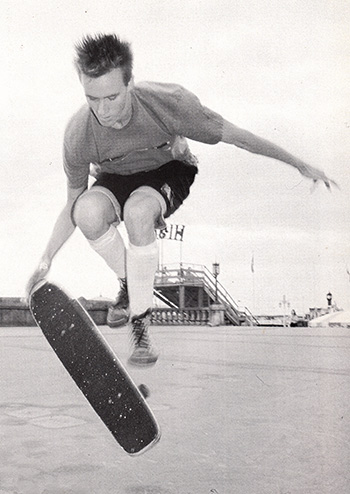 Well back then I just skateboarded, it was never about ‘freestyle’, I was just wowed by Steve Kellner and what he was doing. There was never the thought that I wanted to be a freestyler. I would just skate and what he was doing looked like fun. We used to skate at the Level Skatepark, which at that time was different to what it is now. It was a concrete park but all of the main concrete parts had worn away so it was really just little pebbles and it was really horrible so you really needed soft wheels to skate it.
Well back then I just skateboarded, it was never about ‘freestyle’, I was just wowed by Steve Kellner and what he was doing. There was never the thought that I wanted to be a freestyler. I would just skate and what he was doing looked like fun. We used to skate at the Level Skatepark, which at that time was different to what it is now. It was a concrete park but all of the main concrete parts had worn away so it was really just little pebbles and it was really horrible so you really needed soft wheels to skate it.
It was back in those days that I met Ian Deacon, Neil Hackett, Adam Brinkworth and Justin Ashby—who went to my school. So we’d just skate and create chaos and it was a really tight crew of skaters. Probably no more than ten people in the whole of Brighton and Hove.
I remember an early Thrasher mag in Rough Trade, somebody freestyle skating in a reservoir at Del Mar on the cover [September 1982, Per Welinder shot by MoFo], and since two of my friends had freestyle boards, again I ended up borrowing them and I became a bit obsessive about it. You didn’t need to have a skatepark to do it, you could just go out and find a piece of flat land. When it’s pissing down with rain you just find a parking garage. It was really good.
I was the youngest child of five in my family, my parents used to drink a lot and this was my escape from my family who were just in this habit of watching TV in this same routine every day and it was driving me crazy because I knew I had more energy than what I was getting from that. Skateboarding, and freestyle specifically, was a way of finding my creativity and exploiting that energy that came from within. I’d just go away every night on my friends’ skateboards and just freestyle for a few hours. I’d still go and skate the Level, and go street skating, it’s more that I was just a ‘skateboarder’. It’s not like I labelled myself a freestyler at the time. I never really have.
Pig City seemed like quite a big deal at the time in terms of a shop, scene and crew. Were you part of that?
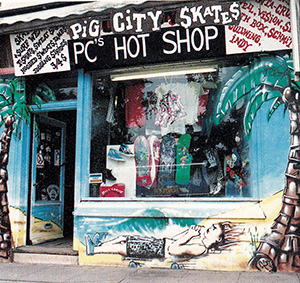 Pig City is over generations, it’s not just one generation, but the original generation was Mark Baker, Simon Levine, Jock Patterson, John Mitchell, but there was a whole crew that were all amazing. There were some big names came out of Brighton. The Kellner brothers–Steve and Brian–those guys were amazing… They were actually from South Africa and they were good at everything—park, street, and pool.
Pig City is over generations, it’s not just one generation, but the original generation was Mark Baker, Simon Levine, Jock Patterson, John Mitchell, but there was a whole crew that were all amazing. There were some big names came out of Brighton. The Kellner brothers–Steve and Brian–those guys were amazing… They were actually from South Africa and they were good at everything—park, street, and pool.
Pig City was born in the seventies and Brighton had a really good skate scene but it kind of overtook a lot of areas because it was so big and the police started getting really aggressive because they saw skating as being a nuisance or a danger to pedestrians’ ankles or whatever. So, it was called Pig City because of all the pigs.
I was more a part of the second generation of Pig City, in the eighties. That was more Ian Deacon and Justin Ashby and Neil Hackett, that whole crew. Mark Baker was still around but he was busy with his side-hustle or whatever, to make a living before he moved to New York and became a kingpin of the city.
Pig City’s still there and it’s a different generation again, but it used to be the case that anybody who skated from Brighton always had a pig on their skateboard. When Pig City would turn up at a contest there would always be mayhem and Ian Deacon was always a good ringleader of that crew.
Ringleader Ian Deacon. Inset below Left-Pierre-André Sensizergue at a Farnborough Contest
When did you start entering contests? Freestyle is quite comp-heavy and there were a lot of European trips going on in the 1980s.
In the early eighties there weren’t really a lot of contests. There was one at Southbank, one in Brighton and there was Farnborough ’81 but they were small. Farnborough was a funny one; this guy Jacko that we used to skate with kinda went crazy and just went off the grid… In fifth form when you didn’t need to wear a school uniform anymore, he would be the guy wearing a school uniform, you know? He started hanging about with us and turned into a full-on alcoholic drug-tweaker crazy man. We took him up to the Farmborough contest with me, Ian Deacon and Mark Gregory AKA Smeg, and Jacko ended up stealing a bottle of Pernod from a supermarket so we drank Pernod and blackcurrant all the way up in the car that night.
I remember when we got there, we were all just puking all over the place. We slept on the ramp and woke up as people started to turn up for the contest and there was puke everywhere.
That’s a good example of why the Pig City guys had the reputation they did, then.
Yeah. It was bad. I was probably 15 or something so I hadn’t really had a bad hangover before then. It was pretty crazy.
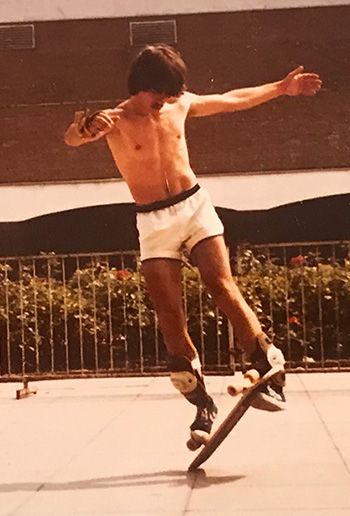 So I just remember waking up and there were a lot of people turning up. I didn’t know it was going to be that big, with all your Sean Goffs and people like that turning up. Sue Hazel, Shane Rouse and the whole UK crew from back then. I can’t remember if [Steve] Douglas and Bod [Boyle] were at that one but there was people from all over Europe… Bruno [Peeters] from Belgium, the whole French crew and a load of Swedish guys. The Swedish were always gnarly.
So I just remember waking up and there were a lot of people turning up. I didn’t know it was going to be that big, with all your Sean Goffs and people like that turning up. Sue Hazel, Shane Rouse and the whole UK crew from back then. I can’t remember if [Steve] Douglas and Bod [Boyle] were at that one but there was people from all over Europe… Bruno [Peeters] from Belgium, the whole French crew and a load of Swedish guys. The Swedish were always gnarly.
When the French crew turned up, that was the first time I met Pierre-André Sensizergue, the owner of Sole technology. I woke up all hungover, and saw this guy with a ponytail, little Dolfin shorts and a moustache and just thought, “Who the fuck is this guy?”
Hahaha! Eighties European freestyle chic.
And he was absolutely killing it. I’d never seen anyone as good as this guy on a skateboard. It was crazy.
I couldn’t even enter the contest because I was so hungover so I just looked at everybody else with a raging headache and nausea. Haha!
Being too hungover at 15 to enter a comp is pretty gnarly.
Yeah, and on Pernod too. I don’t know if it’s true about Pernod but supposedly if you start drinking water it reactivates… I don’t know if that’s possible but it was just a shit day either way. A shit day but maybe also the best day, at the time, too.
Maybe an important day, in hindsight. Freestylers invented a lot of tricks. Did you invent any tricks? Or were you around the invention of any tricks?
At that time I loved rail flips and Casper tricks because there wasn’t a ton of indoor spaces where you could go skate so you’d skate the typical parking garage with piss in the corner and oil stains everywhere. Casper tricks and rail tricks became easy for me because I could just find some flatland and get creative on that. It’s not like I invented a category, but I was able to evolve certain things from Caspers or from rail tricks. Things that don’t have names, just a different version of something like the handstand 360 kickflip landing on feet.
Development rather than creation.
Yeah. It was more an evolution of things at that point.
You first went to the States in ’84, and from then on your time spent in the UK got less and less. How did that all happen?
I was working in Waitrose in Brighton at the time, and during one of the sessions at Churchill Square with Ian Deacon and Justin Ashby and whoever else we just decided that we should go to the US. Everybody that was there at the time, probably about eight people, all agreed that we should do it.
Ian Deacon was kind of the ringleader; he used to work for British Telecom so on his lunchtime he would always call the brands in the US. Just going through Thrasher and calling up every company that had a phone number because it was free through his job at British Telecom. Calling the US from the UK back then was super expensive so the fact that he could do that was very good.
Ian Deacon was kind of the ringleader; he used to work for British Telecom so on his lunchtime he would always call the brands in the US. Just going through Thrasher and calling up every company that had a phone number
One of the bigger brands at the time was Zorlac, and Jeff Newton—one of the owners of Zorlac—picked up the phone when he called, so Ian kept in touch with him and built up a pretty good relationship and that helped when we were planning this trip to the US. Jeff Newton had told us just to come out, and said he’d find us a place to stay or whatever, and it kind of worked from there.
I saved up my money from working at Waitrose; I saved up enough money for a one-way ticket and about £300 to have when I was there. So, a one-way ticket over there and then a five-day Greyhound pass was £99. It’s crazy to think how cheap that is today.
The one-way ticket could have been risky.
The thing with going to the US, is that they quite often ask where your return ticket is, but Ian Deacon had already worked it out… Our story would be that we were going to drive up to Canada, and leave via Canada.
On September 3rd, 1984, we all got on a plane with our one-way tickets and landed in the US. It was me, Ian Deacon, and Smeg. We landed in New York and went down to visit the guys in Texas, in Dallas.
Did you spend any time in New York or did you go straight to Zorlac?
No, we just went down to Texas. When we landed in New York it was probably the heaviest rain I’ve ever seen in my life. It was crazy. Growing up in England, you think you’ve seen every kind of rain, but this was like a fucking waterfall, it was crazy. So there was that on top of the normal chaos of New York, and us trying to figure out how to get to the bus station.
But we got a Greyhound bus all the way down to Texas and Deacon had worked out with Jeff to have somebody pick us up, and when we got there it was actually Jeff Phillips who picked us up from the bus station.
Woah, good start!
That was pretty crazy! Probably the equivalent of a Nyjah Huston picking you up now.
A few lunchtime phone calls and now you’re with Jeff Phillips.
That’s how small skateboarding was back then. It was still tiny; it hadn’t really blown up yet.
So Jeff Phillips connected us up with one of his friends, this guy Tom Barrows. From what we heard, this guy’s dad was one of the major developers of the city of Dallas and he had this rad condo place so we all slept on couches or floors there and just hung out in Texas for a while with all the Texas crew. It was amazing. One day Jeff Phillips saw me skating and said he thought I was good or whatever, and that he’d try to get me hooked up with Sims. Which he did.
Now obviously Sims was on the West Coast and we’re on the East Coast, but we hung out in Texas for a while, at the Blue Ramp and the Clown Ramp which was kind of mixed at the time. Those were two infamous ramps and they chopped them up and put them together and there’s a lot of shots from that place from the time. We went to Austin, which was fucking crazy. It’s this big college party town so it was non-stop drinking down there. It was wild.
Then eventually we decided to head to California, so we got the Greyhound bus across the country to see the West Coast and to go to Sims to pick up boards or whatever. We went straight to Del Mar, and stayed at the skatepark. We slept on these high H-Ball things, which were trampolines with basketball hoops on each side. It’s a bit of a weird thing but it’s a famous thing about Del Mar skatepark that anyone who was visiting would sleep on these trampolines.
Don on his way to 1st place at a Del Mar contest in 1985 while also in residence. Inset Below Right – J.Grant Brittain and Dave Swift in Europe years after Don’s Del Mar connection
They were probably pretty stinking by the time you got there then.
Yeah. And there were tons of mosquitos, and if someone wants to get up for a piss in the night everybody sinks to the lowest point of the trampoline so you wouldn’t get a good night’s sleep there. If we got kicked out the skatepark we’d sleep on the beach which was always a nightmare because it’d always get fuckin’ freezing at certain points of the night.
 Dave Swift helped us out a lot, he worked at the skatepark with Grant Brittain at the time, so Dave Swift would help us. He’d let us sleep on his couch every once in a while, or just help us however else he could. We stayed at Billy Ruff’s house sometimes too.
Dave Swift helped us out a lot, he worked at the skatepark with Grant Brittain at the time, so Dave Swift would help us. He’d let us sleep on his couch every once in a while, or just help us however else he could. We stayed at Billy Ruff’s house sometimes too.
Skateboarding was so small that the fact that you were skateboarding meant you were instantly a friend, you were instantly accepted to the community and it was pretty amazing to be a part of that.
So Sims didn’t exactly have an apartment ready and waiting for your arrival.
No! Haha! When we went to Newport Beach we met Brad Dorfman there and picked up some boards. I can’t remember if it was that time or another time, but he told me he wanted me to ride for Vision instead of Sims. Sims was the brand I grew up with, from the ‘70s onwards, and always felt like the best brand, so that was kind of where my heart was although I didn’t really care because everything so far had kinda been unintentional. Things just happened. It was purely about luck and being in the right place at the right time. I just wanted to skateboard, I didn’t care what brand it was, so whatever. Vision? Sure.
At the time I didn’t know that Brad Dorfman was wanting to build up Vision into this brand that he puts all his time and energy into, over Sims. In retrospect it was actually the best choice ever to go with Vision, because he was wanting to build it up.
With the resources he had I guess he planned for Vision to start out big, to come out swinging.
Vision had been going for a while, but he’d just started to build it up with Gator and Owen Nieder, that kind of crew at the beginning, and then as street skating grew it became Gonz and Johnee Kop on that side of things. It was pretty cool.
And you as their pro freestyler?
No. I was just amateur then, at the beginning. From sleeping at Del Mar and going to pick up those boards to going to the different contests seemed like years apart but it was probably only months apart. We were basically homeless that whole time, we didn’t stay in any hotels or anything. There were maybe a couple of times we all crammed into a hotel but it was mostly sleeping on couches or on beaches, or whatever it took to survive. Eating at Denny’s… They used to have a $1.99 Grand Slam Special 24/7 so we’d eat three of those every day all day. Just pancakes, bacon, eggs, sausages…
Wallride outside BHS on a UK visit. Photo: TLB. Inset Below Left – frontside in a fullpipe in 1988
Punking it.
It was interesting but I suppose it’s typical when you’re 18. When you’re around that age. You don’t really care, you’re just living life and whatever comes your way you just deal with it and you don’t really think about it as long as you’ve got your skateboard in your hand. That’s all that really mattered.
you’re just living life and whatever comes your way you just deal with it and you don’t really think about it as long as you’ve got your skateboard in your hand
So we lived at Del Mar but there was a Huntington Beach contest, a street and freestyle contest, and I think that’s where I first saw Gonz skating. The whole street crew came down; I think Tommy Guerrero was there, all these different guys. It was amazing.
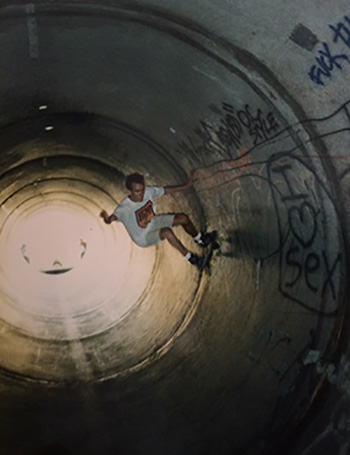 That was the time I realised I had one dollar left. I didn’t really think about money at the time but I looked in my wallet and I had one dollar, and I was in the US with no ticket home. I kinda realised I was a bit fucked, but I saw Brad Dorfman—the owner of Vision/Sims—so I asked him if there was any way he had a job in the warehouse or whatever. He just went, “Yeah, sure. No problem. You can start next week”.
That was the time I realised I had one dollar left. I didn’t really think about money at the time but I looked in my wallet and I had one dollar, and I was in the US with no ticket home. I kinda realised I was a bit fucked, but I saw Brad Dorfman—the owner of Vision/Sims—so I asked him if there was any way he had a job in the warehouse or whatever. He just went, “Yeah, sure. No problem. You can start next week”.
At the time I’d been staying at this other freestyler’s house, this guy Andre Walton who lived in Garden Grove which was probably about half an hour away from Newport Beach. The reason I’m telling you that is because I used to catch a bus from Garden Grove to Newport Beach but it took about two hours every day. Haha! So I had to wake up super early in the morning to even get there at the right time. I later found out Andre told me the wrong bus route and there was another one that took about an hour. Hahaha!
All that after probably having quite a late night.
Yeah! I used to skate all night at this tennis court, which was kind of funny. I’d work at Vision in the warehouse, then get this two-hour bus ride home to eat, then I’d just go skate for three or four hours each night, at the tennis court. That was the routine, every day.
This was at the time when Paul Schmitt came out from Florida, when he had Schmitt Stix, so I eventually moved in with Paul Schmitt because he’d partnered up with Brad Dorfman. He’d started making the boards for Vision and he had his woodshop over the road from Vision. Schmitt’s whole thing was growing, and living with Paul was pretty amazing.
The whole Florida crew were there, so John Grigley, Chuck Hults, Monty Nolder and all those guys would be there. John Grigley worked in the warehouse with me and one day he told me that he’d talked to Brad Dorfman, and Brad had said that if I won my next three amateur contests he would turn me pro.
John Grigley worked in the warehouse with me and one day he told me that he’d talked to Brad Dorfman, and Brad had said that if I won my next three amateur contests he would turn me pro
Right…
When he told me that, nobody had actually guided me, or told me that if I do this, then I get that or whatever. At the time I was probably getting top five, maybe top three, in a lot of the contests I entered. Maybe a couple of firsts or seconds in CASL or NSA contests, but after John told me that I was thinking about winning the next three so Vision could turn me pro.
I somehow mysteriously won the next three contests in a row so I went back to John Grigley and went, “Hey, I won the three contests…”
“Any thoughts..?”
Yeah, and he kind of gave me this weird look, and said, “Oh, fuck, I’m sorry. I actually just made that up. Dorfman never said that”. Haha! But he said he was going to go and talk to Brad anyway, and when he came back he said it was all good and they were going to turn me pro and give me a pro model skateboard. I later found out from Steve Douglas that I was the first skater from the UK to get a pro board from an American company.
Don was the first UK skateboarder to get a pro board from an American company. Vision ad from 1989
Were you coming back to the UK at all, that time?
I was in the US for, I think, eight years illegally. It’s pretty funny when I think back. My parents basically let me go to the US on a one-way ticket with not enough money to come back. Ha! I wonder if that was a hint.
An illegal immigrant and now you employ all those people. That’s rad.
Ha, yeah… So, I came back to the UK for some contests, which was way easier then. What they would do, they would give you a piece of paper with the information written on it and just staple it into your passport. They would stamp your passport with when you came in, but when you left you’d just give that piece of paper to the airline carrier and they’d just take it and put it in a bucket or whatever.
What I found from other travelling skateboarders was that all you had to do when you got to the airline was tell them you’d sent it in for an extension, and that it hasn’t come back yet. And they’d be fine with that. So, when you’d leave the country and come back, all immigration would see would be the stamp to show the last time you came into the country. So as long as you actually overstayed, that was a benefit for coming in and out.
Because it’s not stamped. Amazing.
Yeah exactly. Down the road that all kinda changed. I got married in ’93, and that was when going back and forth to Europe illegally got a little bit taxing, immigration were getting a little bit more savvy and I dropped the whole thing of having to tell my wife, “I hope I come back!” each time.
Don’s TWS cover from 1989 shot at Oceanside by J.Grant Brittain. Inset Below Right: Don’s photo in the Vision ad on the back cover shot by TLB
You’re on the cover of my first copy of Transworld. June 1989, and it’s a silhouette of you in the sunset, shot by Grant Brittain. Getting shot by Grant for the cover of Transworld is quite a big deal.
The big thing for magazines back then was that they had to get coverage of the brands that advertised and Vision, Powell and Santa Cruz pretty much owned the industry and Thrasher and Transworld owned the bigger picture forces of what’s being portrayed and seen of skateboarding around the world. From knowing Grant Brittain from the Del Mar days, from the Dave Swift days, I already had a really good friendship and relationship with him and for him it was easy. It was like, “You’re a freestyler, we can just go anywhere because you don’t need a pool or a ramp or anything”. Grant was definitely one of the people I shot the most with in the eighties.
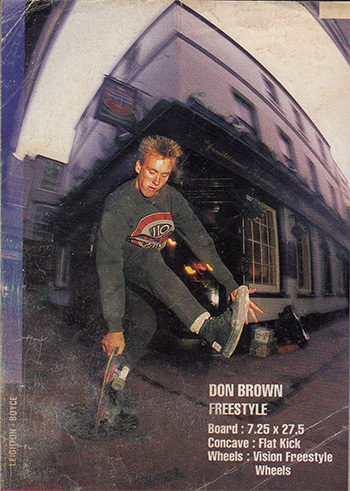 I think I just went by Transworld one day and he was there and asked if I wanted to shoot a picture. We went to the beach at Oceanside, which is where Transworld was, and took a few shots. The silhouette shot came out and luckily I got on the cover of the magazine.
I think I just went by Transworld one day and he was there and asked if I wanted to shoot a picture. We went to the beach at Oceanside, which is where Transworld was, and took a few shots. The silhouette shot came out and luckily I got on the cover of the magazine.
You’re on the back cover of that issue too, in a Vision ad.
Oh, I was?! Haha! I haven’t seen that mag for years.
Alright, so around about then you met Pierre again.
So, Pierre came over in ’85 and was travelling around but he lived in Huntington Beach. He was in the same situation as me, sleeping on floors and couches, just in a difference region. Nick Humbenhower—one of the English guys out there—had a little apartment and Pierre used to rent this little 7’ x 7’ space behind the couch. Haha! That was pretty funny.
With Pierre there are a lot of weird things when I look back and I can’t help think that there was some kind of destiny there. I believe a little bit in destiny in life, like when you’ve got a passion and a love for something, things come to you. Things are attracted to you; you magnetise the things that you want in life when you really love something. Skateboarding is my love but it created this bond, this friendship, with people who have become a staple in my whole life.
When I met Pierre in ’81 I had no idea I’d be working with him for over thirty years. I had no idea that when etnies launched in ’86 that the first team they sponsored was Pig City in Brighton. I was in the US at the time so I had no real knowledge. I knew the guys but I wasn’t part of that whole crew. All these things you look back on, all these people or places or things, were they already set in place? Did I just need to turn up?
Don and Pierre side by side in a Vision Street Wear Ad from 1989. Inset Below Left – Mr July in Vision Street Wear’s 1988 calendar during Skateboardings second ascent
Don’t fuck it up! Just be there!
Yeah, there’s definitely a little bit of that. Being the youngest of five in my family, I’ve always believed that the youngest in the family is always a little bit of the follower and more on the creative end of things, whereas the older ones have to be more in leadership positions to take care of the rest of the kids. The youngest in the family doesn’t really need to think, growing up, because all your siblings do all your thinking for you. “It’s mum’s birthday next week”. “Oh, OK”… I never had to remember mum’s birthday because everyone else in the family would tell me.
And you’ve got a steady supply of cool clothes, music and opinion all there, waiting for you.
I’d get all the hand-me-down clothes, which is awkward when you’ve got three sisters and you have to wear your sisters’ knickers. Hahaha! Kidding. It’s just interesting when we can all look back at life and see the things that happened and wonder whether it was destined to happen.
There might be some of that, but I think that stuff has a lot to do with making the right decisions at the time. Gary Player, the golfer, said, “The more I practice, the luckier I get” and I think that’s the right way of looking at that.
There’s definitely that element too, yeah.
So explain the cycles of skateboarding.
There was a definite boom-and-bust where the beginning of the decade would be the early adopters, and then at the end of the decade it would peak and be the biggest ever and then sudddenly crash. Skating completely blew up in the in the mid-‘70s, then crashed and became almost nothing by the end of 1979. There were almost no skateboarders in the US by 1980. It was done.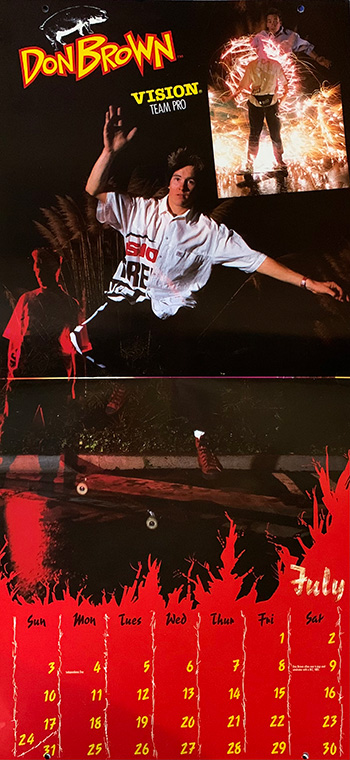
The same thing happened in the eighties. I was one of the early adopters and around ’80 to ’84 skating was a handful of punks around the world, but by ’89 it had reached the highest peak it had seen and attached itself to a lifestyle with apparel and all that stuff.
1990 it crashed again and then became this skater-run thing, and in the mid-to-late nineties it boomed again. So that cycle happened three times and I felt that it happened in 2000 to 2010 and 2010 to 2020 but it happened in a different way than with past cycles.
What was that different way? I was expecting it to crash again…
You remember that then?
I remember when it died in the nineties but in the 2000s it just seemed huge. The Tony Hawk video game, the X-Games and all that stuff. But you’d be in a better position to know…
It didn’t dip in the business side of things because of the things you mentioned. That whole period of building up to the end of the nineties was a different, digital world. The Tony Hawk PlayStation video game, the X-Games, kids creating and editing their own sponsor-me tapes and that demographic of 13-to-16-year-olds was booming, so everything was in its favour to not go down in a business cycle but to go up. In my mind, that was the ‘mainstreaming’ of skateboarding. That was where it became a mainstream thing and the point where Nike became interested and realised there was actually something viable there, to get behind. There was a business opportunity and demographic that they needed to own.
The cycle of skateboarding grew because of this anomaly of these key pieces of energy that came in, but the age group in skateboarding—the time when people start skateboarding and the time when people stop skateboarding—is usually between 13 and 17/18 and generally that period before people have girlfriends or cars or whatever.
Once people have a set of car keys, or they have to go out and get a job in the real world or they find alcohol or drugs or whatever the hell it is, then for a lot of the population that diverts them towards other things in life. Like becoming the model of what everybody wants them to be in society. Get a job, get a car, get a house, then the time spent skateboarding is less and they fade off but then a whole new generation comes in.
I think that cycle is always there, but there’s certain people like us for whom skateboarding is our life; it’s not just something to do as a pastime. I feel like that boom-and-bust is still there, it just goes in a different cycle based on that overall macro-economic situation and the demographic situation that’s happening in the world.
And it moves so fast now. It’s much harder to predict what’s next.
Exactly, and I feel that skateboarding now is in the same period, just in a different way, as it was in 1991. There is a fuckin’ shitload of kids coming up who are better than a lot of the pros out there who just haven’t been seen yet. They’re going to be this huge force that comes in and just sledgehammers the hell out of whatever’s out there. Obviously we know that there’s more to it than just being good, you have to have a lot of things to go along with that, but I feel like there’s going to be a big evolution in skateboarding.
In the bigger picture, the mainstream brands came in and they really controlled it, but now we’re seeing Nike and adidas retract and pull out which opens up more opportunity for more footwear and apparel brands. So there’s more opportunity for skate apparel brands to pop up again and just put skateboarding back in the hands of skateboarders.
Don shot by Miki Vuckovich for the TWS coverage of Munster World Championship 1989 / Winning first place
Skateboarding isn’t just one thing anymore. There’s loads of different versions of skateboarding now. There’s the 6 year-old girl’s version of skateboarding, there’s the 50 year-old man’s version of skateboarding, the 18 year-old’s version of skateboarding, and these people all want and expect something different from it. As long as everybody is being catered for, then hopefully everything can continue to flourish.
Exactly. It’s interesting, and there’s a whole other thing with the Olympics coming up. That’s going to grow the foundational side of skateboarding with more parks being built. It’s not the skateboarding we grew up with, and I always make sure I never get my values stuck with a certain generation of skateboarding. Personally, I’d prefer to just skate a piece of shit concrete in the middle of nowhere that realistically sucks than go to a perfect skatepark because I grew up with observing my environment and wanting to challenge it. It’s just different mindsets.
You see people like Sky Brown now, who are growing up with perfect parks, and they’re growing up skateboarding the way that most people grow up walking. It’s become a natural extension of their limbs and they can do anything they put their mind to, which is amazing and that’s why I never want to hold back and have this salty perspective of, “Fuck all these new guys!” I think it’s amazing, the evolution of skateboarding and the constant cycles of it always evolving and always progressing forward. That’s the beauty of skateboarding. It’s never stagnant.
I think it’s amazing, the evolution of skateboarding and the constant cycles of it always evolving and always progressing forward. That’s the beauty of skateboarding. It’s never stagnant
Sky Brown doesn’t care what we think anyway. She shouldn’t give a shit what the best Keenan Milton photo is, and that’s fine.
Haha! She wouldn’t know what you were talking about. “Isn’t Keenan Milton a town in England where James Bush skates?”
Ha! So with these dips in skateboarding, freestyle was definitely a casualty when the nineties rolled around.
Oh, for sure. Vert and freestyle got completely chopped out. The eighties was a really interesting time because for the first time the lifestyle component of skateboarding blossomed. Brad Dorfman at Vison had the foresight to create beyond just a skateboard and to create apparel and footwear, to create this lifestyle around it where even if you’re not a skateboarder you can still buy into it. The surf industry tapped into that, with Quiksilver and Billabong and Gotcha. They figured out that people wanted to buy into surf and beach culture, so they made apparel that was associated with that. People would think, “Oh, that guy’s cool. He’s wearing a Quiksilver shirt, so he must be a surfer”.
It was the same in skateboarding. Suddenly it was like you could ‘look like a skateboarder’ so Brad took the brand and sold it out to the big department stores and chains of retailers around the world, made millions and became the biggest skate brand.
Outside the Grand Brighton Hotel with Tim Leighton-Boyce in 1990
Did you have a board on Vision when that sale went through?
Yeah. I got the pro board in, I think, ’86 which was also the time I entered my first pro contest at Oceanside. So, I had a board from ’86 until, I think, ’91 when things came to an end. I can’t even really remember the end, it was strange. It was weird because I could kinda sense skateboarding coming to a freeze. I was riding for the biggest brand in the eighties and when the nineties came, it was still on fire with all the big Münster contests and all that stuff but I think the reality behind the scenes was that things were changing. And I believe that a global recession was kicking in at the time too, which always affects skateboarding.
1990 Steve Rocco came in, and he hated established brands. He hated Brad Dorfman. He hated George Powell. He hated Transworld. He hated how they just controlled skateboarding and no-one could really get in so he just made fun of them.
When skateboarding was dipping Vision got stuck with a full warehouse of inventory, mostly apparel and footwear, so they went Chapter 11 and had to file bankruptcy and Rocco came in like a fuckin’ suicide bomber with nothing to lose. He came in like, “I’m gonna eat these motherfuckers alive” and that’s when he stole graphic artist Sean Cliver from Powell, stole Gonz from Vison, stole Mike V, just stole everyone he wanted and just said to them, “Do whatever the hell you want, just make stuff. I don’t give a shit”.
The ‘80s were a time where if you got a pro board, it stuck around for years. I was on Vision for a long-arse time, from ’86 to ’91, but I only got two pro boards during that whole time. It was the same for a lot of the pros; a Caballero board would be in the line for a year or two back then. When Rocco came in he changed the dynamic of the actual business to where it seemed like pros were getting new boards every week. The market was eating it up and he just thought, “Fuck it, I’m gonna give everyone a new board every week” or something, to the point where the big guys couldn’t even comprehend let alone keep up with it. The fast turnaround of boards also helped not get in lawsuits with the graphics that were highly controversial or ripping off corporate branding.
Steve Rocco III stickers on Don’s board in this Joe Polevy photo from a 1990 Poweredge. . Inset Below Left – With wife Paulina, together since 1987
I don’t think Rocco could keep up either; I had World boards that had the new graphic screened on top of the previous graphic.
Oh wow, I didn’t know about that. Haha!
So ’91 comes around, the industry is imploding and I get the message from Vision that they can’t pay me anymore. I was kind of salty with Brad at the time but understanding it now I know what a fucked up situation it is when shit gets challenging. He just didn’t know how to react or what to do, so he had to make abrupt changes to the program and basically wipe everyone out because he couldn’t pay them or do anything because the money wasn’t there anymore and he was in huge amounts of debt. So that all came to a screeching halt.
I rode for Gullwing and they were paying me $200 a month or whatever, but I just called them up and said I was done, it felt like the right thing to do even though I needed the money.
And it really was that fast. Lots of things just finished and that that was that.
It was crazy but life’s all about change and evolution. It’s a cycle and we were part of that cycle. We knew that that had happened before so maybe we should have planned a bit better for it.
But it’s not like you’re calling up your old boss at Waitrose, is it?
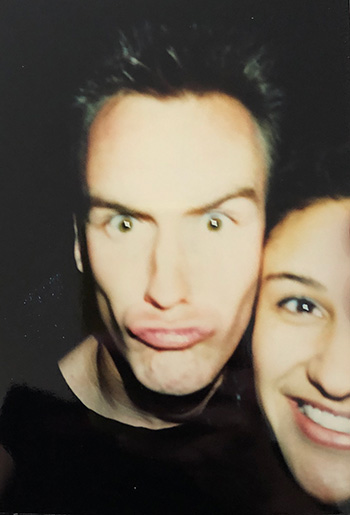 No. For sure Haha! I used to skate down at Huntington Beach pier and I ended up working at this rental shop. They wanted to start selling skateboards so I worked in the skateshop selling skateboards. I’d just skateboard and work there. I was living with my wife Paulina and her parents at the time, and they were good at helping me out.
No. For sure Haha! I used to skate down at Huntington Beach pier and I ended up working at this rental shop. They wanted to start selling skateboards so I worked in the skateshop selling skateboards. I’d just skateboard and work there. I was living with my wife Paulina and her parents at the time, and they were good at helping me out.
One day Pierre came down while I was skating and told me that he was doing the etnies thing and he could use some help with it, so I said yeah. That’s how I ended up working with Pierre and doing the etnies thing. Thirty years later and I still feel like I’m helping a friend versus having a job.
In the context of the bigger picture, you had Airwalk at the time who were a company worth hundreds of millions of dollars but they just plummeted. Billy Ruff was one of the sales reps and I remember seeing him in a shop at the time with this big bag just trying to sell to anybody who would buy Airwalk shoes. Vans had gone out of business and Simple were kinda doing their thing but I think Eric Meyer had just sold the company, so it was chaos.
Being involved with etnies was perfect since I had the relationships with the majority of the pro skaters from the ‘80s. I’d be the guy drinking beer at Münster with Steve Schneer and the vert/street skaters at 4am when I had a contest to skate the next day, so I had those connections with the whole skate community which made it easy for me when I first joined because I was able to hook up these top pros who were losing their sponsorship from Airwalk and Vans or whoever.
At the time Rocco was creating this whole skater-owned movement, and Tod Swank—who I was really good friends with from the Del Mar days—had Foundation Skateboards going. Then there was Paul Schmitt and Steve Douglas with Giant distribution, so two of my best friends there. I had these instant connections where I could just call up these people, and there were sales guys working within these companies who I’d known forever and I’d just call them up like, “Hey, who have you got on your team?” and obviously with New Deal you’ve got Ron Knigge, Armando Barajas, John Montesi and Ed Templeton.
I had the connection with Rodney Mullen and Rocco, so I hooked up Rodney and he’d skate with Daewon all the time, which meant I could get shoes to Daewon. Natas had the 101 stuff going on, so there was that connection there. There wasn’t anybody getting paid to wear shoes in skateboarding, and since Airwalk and Vans were done it was easy as a skater-owned brand who had the friendships with all these people to just lace people up with shoes, and then it started growing.

Shoes were changing a lot at the end of 1991.
It wasn’t easy at first because some of the shoes were a little bit off-point, with the transition from bigger bulky shoes of the eighties. etnies actually pioneered the new direction with slimmer silhouettes and eliminating thick rubber overlays. The suede Rap, Senix and Locut shoes really changed the game.
Didn’t the low version of the Rap come out before the Half Cab? Didn’t etnies release a chopped-down version of an older shoe before Vans did it?
That’s what I think. There were a lot of things going on at that time. Kris Markovich, Mark Oblow and Quy Nguyen were all local so they’d come by etnies all the time. I’d been giving them the Rap shoes, and I noticed they would take a knife and cut from the inside, then fold that over to make low-cuts, so we realised we need to make low-cut shoes. That’s when we started doing the low-cut Rap and the Senix.
This is going back to before you were involved, but isn’t it the case that the Natas shoe was only available in Europe at first?
Yeah. etnies was mostly a European brand and they didn’t have the understanding of how to penetrate the US.
So how did etnies get one of the greatest skateboarders ever, who’s in America, to wear their shoes?
This is another one that’s kinda crazy… Destiny or whatever you call it. So, the original owners of etnies were this French company called Rautureau, which was this big fashion conglomerate. Runway fashion, all the crazy shit. The guy’s son skated, and he—the main guy, Yvon—would always look at skating as this super creative, energetic thing that wasn’t a sport but it was an art. A culture all by itself. He saw that skateboarders would travel around in groups, so that’s where Etnics—the original name—came from, like ‘ethnic tribe’. But Etonic saw the name and sent us a cease and desist because it was too close to their word, so it got changed to etnies.
So anyway, imagine working there, for this French company, and the guy who owns it comes in with a copy of Thrasher and says “I want this guy on the cover to be on etnies!” All the skaters there just doing their thing, thinking, “Well that’s fucking impossible, that guy is the best street skater in the world”.
The first Natas Kaupas Etnies ads from 1989
“I want Ronaldo to play for my pub team.”
Exactly, right? It seemed like a pipe-dream, something that was so out there. But this guy Yvon ends up going on a business trip to LA and decides that while he’s out there he’s going to go to Venice and see if he can find Natas. He goes to Rip City skateshop—which is still around today—and goes up to the guy behind the counter—who happens to be Mic-E Reyes—and asks him, “Hello! Bonjour! Do you know this guy on the magazine?” or something. Something along those lines. But then Mic-E goes, “Yeah, sure”, and he went and grabbed Natas! And that’s how the whole thing happened.
The whole theory behind it was, ‘Why do skateboarders wear basketball shoes with basketball players’ names on them? Why are skateboarders buying these shoes and supporting basketball rather than buying within their own communities and supporting each other and investing back into skateboarding?’ It seems obvious but it was genius.
So when the shoe got made, could people in America buy it?
They were doing all the production and design in France originally, and around 1989 Pierre took over the distribution of etnies in the US. Then he eventually took on international distribution, which was Japan and Australia. There was an issue with Japan, where they hadn’t got the trademark for the etnies name so someone took the name and made all these crazy-arse etnies shoes, just the craziest shit ever.
Like the fake Supreme shops in Italy and Spain.
Right. So Japan for a while was a write-off, we couldn’t even sell out there, but Australia was really amazing. So Mic-E Reyes ended up riding for etnies, and Jim Thiebaud rode for etnies. Eric Dressen and Rudy Johnson too. It was a solid crew of people, and on the Europe side of things you had all the Pig City guys.
Sal was on from 1990. That was quite perceptive, getting him on early.
Yeah, that’s another one. Natas loved all the Fila-style shoes, and Ellesse kinda shoes, their street looks. That’s where the vibes of the Natas shoe came from, as you can tell. The Rap had a bit of those Fila vibes too, in the blue and red. That’s a thing that I think etnies helped to pioneer, the borrowing from street culture. Taking things that were happening in street culture and kind of injecting it into skateboarding to the point when you’re ‘on-trend’ with a shoe you can actually skate in. You couldn’t skate in those other shoes but you could skate in the etnies. And it was about making those shoes relevant in street culture.
Fila feels in this Ronnie Creager ad which appeared in Big Brother 5 in 1992
Skate shoes you could chill in too, rather than them having loads of plastic panels.
That was the whole thing. ‘Quality, comfort, style’ was the tagline back then. It was always about making a shoe look really good and still be skateable. It’s funny because the skate fashion of the eighties was about these big rubber overlays, it was about high-tops with all this ankle protection. It was all about this stuff that was so functional and beautiful in its own way because it created the category whereby if you wore those shoes you were 100% a skateboarder because you had no other reason to wear them.
So etnies helped pioneer the drive towards street culture, where we took away the rubber layers on the outside and put them underneath so that when you wear through the suede there’s rubber underneath. Just doing more things from a skater’s perspective. As kickflips and flip tricks were progressing we figured out that people liked suede more.
Right, because it catches griptape better. How do you go from having an idea for a shoe to that shoe existing on retail shelves? Can you explain how shoe design happens?
It comes from a functional standpoint. Being skateboarders, it comes down to durability, comfort and style. That’s an advantage we always had with being skater-owned that Airwalk and Vans didn’t have, with not being skater-owned. We knew what we needed to do to make a better skate shoe than what they had because we were skateboarders. We didn’t have to go through the process of hiring all these skateboarders to tell us what we needed to make.
 Pierre’s a really good designer and he would just work with the riders to create stuff or he’d already know what he needed in a skate shoe himself. Even I ended up designing shoes. You’d sit down with the rider, whether it’s Ed Templeton or whoever, and ask them what they like about the shoes that are out there right now, ask them what their favourite shoes they’ve ever worn have been, what’s important to them, what problems they might have with shoes in terms of pain points and how we could try and fix that. Then you start coming up with things like lace savers and lace loops to avoid abrasion, and you start using triple or quad-stitching in certain areas to make sure it lasts longer than a single stitch, or we’ll use a thicker suede. ‘Oh, you’re vegan? We’ll use synthetic material then’. Boiling all these ideas down.
Pierre’s a really good designer and he would just work with the riders to create stuff or he’d already know what he needed in a skate shoe himself. Even I ended up designing shoes. You’d sit down with the rider, whether it’s Ed Templeton or whoever, and ask them what they like about the shoes that are out there right now, ask them what their favourite shoes they’ve ever worn have been, what’s important to them, what problems they might have with shoes in terms of pain points and how we could try and fix that. Then you start coming up with things like lace savers and lace loops to avoid abrasion, and you start using triple or quad-stitching in certain areas to make sure it lasts longer than a single stitch, or we’ll use a thicker suede. ‘Oh, you’re vegan? We’ll use synthetic material then’. Boiling all these ideas down.
Then that gets sketched out and the inspiration of the style of what the brand represents already, combined with whatever inspiration is behind the rider or the designer at the time and the brand direction—where we feel things are going, or things we want to push at that time—all gets put in the blender, put in the oven and then there it is.
The layout of the shoe design gets sent to Asia with the tech pack—the layout of the outsole and all the different detailing—and they make the molds out there then make a sample which they send over, and we test it to make sure it’s good. If there’s any tweaks needed we just keep tweaking it until we can boil it down to just what’s needed.
Then it goes to sale samples, and from sale samples we create catalogues and those catalogues go to our sales reps who go out and hit up all the skate shops. We get the pre-sales booked in, and once we get all the orders in for that shoe we discuss whether we want to order to the pre-booked amount that the shops ordered or if we want to order a little bit more. Then the shoes come in, get shipped out and the cycle keeps going.
Paulo Diaz and Jahmal Williams Etnies Ads which appeared in Issues 10 and 11 of Big Brother
Sole Tech owned its own factory, right?
No, we’ve never owned shoe factories, since things change socio-economically. Just on the macro side of things, the bigger picture in Asia with the currency exchange and various other things to the point where there was too much volatility with being in just one country versus another. We actually went to Taiwan for the Koston 2 because we couldn’t get the Koreans to make what we wanted, so that opened up a whole new direction in the construction of shoes and the lasts and things. China has been a big one too, and then more recently it’s moved to Vietnam because of a lot of the trade restrictions around stuff going into Europe.
I guess it’s just about constantly keeping on top of it.
Yeah. DC owned their own factory for a while but it’s not recommended because there’s always things changing and moving so that could become a big liability.
We came from this really safe place in the eighties, with three big brands controlling the industry to complete chaos
etnies ran some really good ads in Big Brother, when Rocco started that up. It feels like the existence of that magazine allowed etnies to become what you wanted it to be. Like you could do your piss-take Nike and Fila logos now.
That early-nineties period was pure anarchy. There was that scary thing of nobody knowing what the hell was going on or who was in control. We came from this really safe place in the eighties, with three big brands controlling the industry to complete chaos…
…and skateboarders controlling the industry.
Yeah. And Rocco, the guy everyone was looking up to, was just going, “I’m going to fuck with everyone”. It was really cool but it was sketchy that the inmates were suddenly running the asylum, or whatever. I mean holy shit, those kids were given the freedom to do whatever the hell they wanted.
Me and Pierre doing etnies, we were the skater-owned shoe company component of the whole puzzle of skater-owned board brands and wheel brands that totally blossomed. You’ll know better than me but there must have been hundreds of brands around the early nineties, with people coming out with all kinds of weird shit.
Mike Santarossa and Kris Markovich Etnies Ads which appeared in Issues 7 and 9 of Big Brother
Yeah. All these companies that might only have lasted for a month and who spent their entire budget on one ad, but they were still a company with a logo and team for that moment.
And meanwhile you’ve got fuckin’ Gator murdering his girlfriend which felt like the stresses on the ‘80s generation of pros not knowing how to deal with life without big cheques coming in. I didn’t make much money skateboarding because I never really cared about money but Gator and all these superstars? They had the same shit happen to them as happened to me as a freestyler where things came to a crashing halt overnight. There’s just a huge difference when you’ve got a mansion up in fuckin’ Beverly Hills and you’re living the rockstar life. When everything came to an end overnight I wasn’t making much so it didn’t take much to transition into normal life. But for those guys?!
I remember going on demos with Gator towards the end and he was fuckin’ struggling. We went on tour with Kele Rosencrans and all these young guys who could ollie into their tricks. Ollie into backside airs, out of the ramp. Gator couldn’t do that, He was still trying to hit the coping to do his airs and then trying to hit the streets and failing at keeping up with the progression of the new generation
There’s footage of him trying to street skate from that time and he can’t even get the board off the ground. It’s like he even struggles to push.
Yeah, him trying to street skate… He’d built his entire career off of one side of skateboarding and it came to an end overnight. It came to an end and then instantly there was this whole uprising of skater-owned brands, and etnies was part of that uprising. Printing on a skateboard is pretty easy to do, but to make shoes takes thought and planning and business acumen, so not everyone can do it.
Pierre already had the people making the shoes, all we had to do was market, distribute and sell them and eventually learn the design and production process.
And be on top of what people wanted. The Lo-Cut with the ‘E’ turned into three stripes was a good example of that. And the etnies ad in the first 411. Just knowing what sort of stuff you should be doing. It’d have taken Vision a year and twenty focus groups before they thought about doing a sports brand pisstake logo on a low-cut shoe.
Exactly. It was a free for all and nobody understood business or law or anything like that. If people liked a logo they’d just take the logo and change it into their brand and use it. I’m stoked that etnies was one of the first to pioneer this in footwear which trickled into street wear culture.
‘Wild Mean Fairly Hip Kid’, all that sort of thing.
Yeah. It was anarchy and the youth had really taken over by that point. Sal Barbier was one of the first I think, when he had the Plan B board with the Ralph Lauren graphic. You could say he was one of the first to ‘borrow’ from corporate culture, and he definitely helped kick that off.
Ahead of the curve. Sal Barbier chilling in the first ad for his shoe and Rene Matthyssen’s heelflip in a pair a few months later
I was definitely in the target demographic at the time, but it really felt like ‘we’ had taken over. Did you ever get letters from these big companies?
One of my old roommates, Gorm Boberg, who was the graphic designer for New Deal and worked a lot at Zero Sophisto with Andy [Howell] already had his graffiti thing on the go, so you’d see that influence in a lot of the graphics he used to do. We’d just sit there and play around with stuff, and he did the Fila etnies logo, and the Nike swoosh etnies logo.
I went to Bud’s skate shop, our local shop to where we lived, and it was at the time a lot of the guys were wearing Puma Clydes with the big fat laces, or shelltoes, and regular people were wearing [Nike] Cortez, so a lot of the skate shops were buying deadstock from these big warehouses. I remember grabbing a bunch of them in Bud’s skate shop and tracing them out, and we did an exact three-stripes, but just put a line across the top to make the E.
I gave that to Pierre and then actually took off for a bit. It’s a long story but Pierre’s partner at the time was a nightmare because he’d came from Vision to help with production and he didn’t really care about skateboarding. I went travelling around the North of Africa for a bit and when I came back the designs had all been put together, but the ‘E’ had been rounded-off.
Etnies Lo-Cuts enable Heath Kirchart’s varial heelflip for Rick Kosick
There are multiple versions of that shoe but to your point, adidas did start hitting us up to say that we can’t do this, because if your trouser leg goes over the top of the ‘E’ then it’d look like three stripes. At the end of the day, when you’re dealing with a multi-billion-dollar corporation you just have to kind of agree or you’d go out of business just with lawyer fees. Remember Nick from Anarchic Adjustment?
Of course, Nick Philip.
Yeah, he was one of those pioneers too. Ripping off the Shell logo and making it ‘Hell’ or whatever, and then suddenly every skate brand is ripping off everything possible and screening it on a board. I think that helped Rocco, when he realised he could just make them for a week and then move onto the next thing so no-one can keep up. You can do whatever you want as long as you do it quickly enough so that nobody knows what happened.
Yeah, by the time the lawyer’s letter has been drafted up and they’ve figured out where to send it, all the stuff has already sold.
Yeah, it’s already gone. And that’s if they even knew about it. So, we were part of that whole, ‘Fuck it, we’ll do our own thing’ movement when we put the Fila logo on our shoes, so Fila sent us a cease and desist too. We never did anything other than shirts with the Nike thing.
When the low version of the Rap came out, it was called the MC Rap. Was that to do with Mike Carroll?
Mike Carroll used to wear the shoes, so a lot of people thought that it was named after him, but it wasn’t. The Beastie Boys used to love the Rap; Mixmaster Mike used to wear etnies so I’m pretty sure it was named after him as the MC, like a rap MC.
Tom Penny Etnies Ad which appeared in the Big Brother East Coast Issue in 1995
By 1995 shoes were getting a lot more tech and you started éS. Was there much debate about whether or not to start a new brand for this new type of shoe?
OK, so as we were doing the etnies thing, I’d always questioned Pierre about why he was paying these French guys a licencing fee every month when they weren’t doing anything. We were the ones doing the designs, the ones with the connections and the ones generally doing everything. I thought we should just create a new shoe brand and do something else.
At the time I was hooking up pretty much every one of the top guys in skateboarding with etnies and it just made sense. We were starting to see more brands coming in, more brands interested in doing stuff.
Ken Block had come up to us and he wanted us to make shoes for him, for Droors clothing, so we made the first Colin McKay and Danny Way shoes and got those working. At the same time as that was happening, we knew we had to do another brand, to get more space on the shelf wall because we knew the marketplace was going to grow. We figured that the more brands we had, the more space we’d have in shops.
You’d have known what DC were wanting to do, from working on those first two shoes?
Yeah, but it was more about us having always wanted to do it anyway. What’s the point in doing all the work and paying those French guys money, you know?
So we created éS and I put together the team of Koston, Penny, Muska, Burnquist, Creager… We knew the trend in skateboarding at the time was more athletic, so we wanted to position the brand as this elite, athletic, sporty, technically innovative skate footwear brand.
There’s a guy, Alex Wise, who’s actually an English guy that’s lived in Paris for most of his life, who’s a really amazing designer. He loved all the fashion stuff, and he provided a lot of the inspiration for the etnies branding and logos. Like using fonts from Vogue magazine or whatever, having all this fashion influence. He’s the one who created the red and white éS script logo.
We knew the trend in skateboarding at the time was more athletic, so we wanted to position the brand as this elite, athletic, sporty, technically innovative skate footwear brand
Tom Penny éS ad from 1996 for the contour, one of the first shoes they released
That logo was really unique when it appeared. Everything else was really bold and masculine, then there’s this delicate little artwork. How did the manufacturing process change when you started to make much more complex shoes?
The original ones were pretty easy. There was the Accel, the Uno, Contour, Stylus… There were a lot of shoes that weren’t too hard to change, even though they were becoming more technical. There definitely became a point though, with the Koston 2…
…it’s the Koston 2 I was thinking about.
Somebody just bought that sample, so it’s floating around somewhere out there. The first sample was just a really blobby shoe. Because it’s this running/athletic/basketball shoe; the last is different. I remember we kept sending samples to Korea to get it how we wanted it and they kept fucking it up and fucking it up and eventually we went to Taiwan to do it. They were better versed in doing that style of shoe with that type of last, with all the different foams. For that shoe we actually had Phylon, which is a lightweight polyurethane EVA-based compound, so yeah, we had to change factories.
At the same time, we changed the designers. We brought in Franck Boistel, who was actually from the original etnies in France, and he’s a phenomenal shoe designer who really helped change the game as far as footwear design at that time went. He worked on the Koston stuff from that point on, and he worked on the Muska too. The Koston 1, I worked on with Eric before Franck was on board, but going forward through Eric’s shoes, it was mostly Franck that did those.
So, you’ve got etnies blowing up in ’93. Shit was just going crazy and skateboarding was starting to get that energy again… It wasn’t quite there but the momentum was definitely building again. Skate shops were starting to sell some shoes. I used to do all the sales and I remember talking to a guy up in Canada and he was all like, “I don’t know what you guys are doing, but please keep doing it because I have people come into my shop who don’t even skateboard and they’re buying your shoes”. I always remember that because that was a defining point for me. I didn’t really understand what he was saying at the time, but he was saying that skateboarding was reaching that level, that lifestyle level, to where people who don’t skate wanted to buy skate brands.
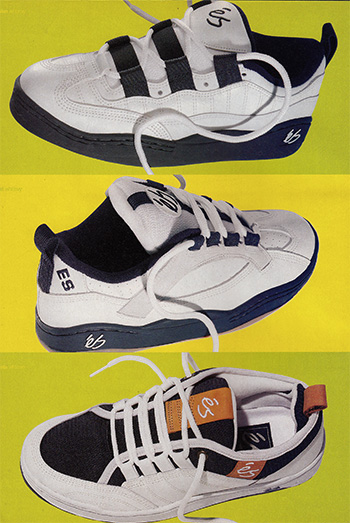 And nobody else was making dope, high-tech shoes.
And nobody else was making dope, high-tech shoes.
What I love about Pierre is that he’s never really put the business first, it’s always his passion that’s first before profit. Which can sting you in the arse sometimes. But he wanted to go snowboarding and he didn’t want to wear Airwalk because Airwalk were the competition. Vans had snow boots but Vans were the competition too, so he went, “Fuck it. I’m going to make my own snowboard boots”. So ThirtyTwo snowboard boots was born in ‘95 too. So we had etnies, 32 snow boots and éS.
Snowboarding had kinda found itself by ’95 too, it had separated from skiing and become its own thing.
Exactly! We had a lot of struggles with that one because we just couldn’t get it right. We’d just transitioned from the time of Sorel boots and duct tape, you know? It hadn’t really evolved much so those were interesting times. The first boots we did with ThirtyTwo were basically two etnies shoes: the Lo-Cut and the Rap.
So you were talking about making sure the factories are capable of producing what you need.
Yeah, there was a lot of pressure on the factories to innovate and push forward. Etnies had taken the cup sole thing to a whole new level but éS was more about injecting more technology in. Like if we wanted to do a cup sole, giving it a more techy feel.
The éS Aura was the first air shoe in skateboarding. The patent Nike had had expired, so we jumped on it and had the first skate shoe with the air pocket.
The éS Aura was the first air shoe in skateboarding. The patent Nike had had expired, so we jumped on it and had the first skate shoe with the air pocket
Was that hard to do? It took Nike a while to figure out how to do that right.
We didn’t really have any issues with that. At the time there’s always going to be a few defects here and there, or with people who would just puncture them themselves and send them back or whatever, but over all that wasn’t an overwhelming issue.
You knew what you were doing by then.
Yeah, and a lot of it had been a lot more basic. From the etnies era and doing the Rap, the Intercity, the Skol, the Lo-Cut… These were all on a similar outsole with a similar upper as far as metal eyelets, triple stitching and whatever, but then with éS we wanted to inject more of the athletic vibe and technology of the time.
At the time, Muska and Koston and Penny were taking skateboarding to a whole other level so we really wanted to keep the shoes up to their level of innovation too, to make sure they can withstand the forces required for their skateboarding.
Tech development aside, each of those shoes identified those individuals. Those pro models epitomised who those guys were.
Yeah, exactly. Back then, skaters would wear their skate shoes to skate, and then a lot of times—especially at the times when no-one was really getting paid to skate—those guys would wear the shoes of what their lifestyle was like outside of skateboarding. So Koston would come in wearing a pair of Jordans or whatever, because he loves basketball, or Muska would come in wearing a pair of Timberland boots so you’d look at what they were wearing when they’re not skateboarding to get inspiration for what we need to build around. So even the brown Accel, that took colour inspiration from a Timberland. A lot of Eric’s shoes were inspired by some form of basketball shoe or crosstrainer.
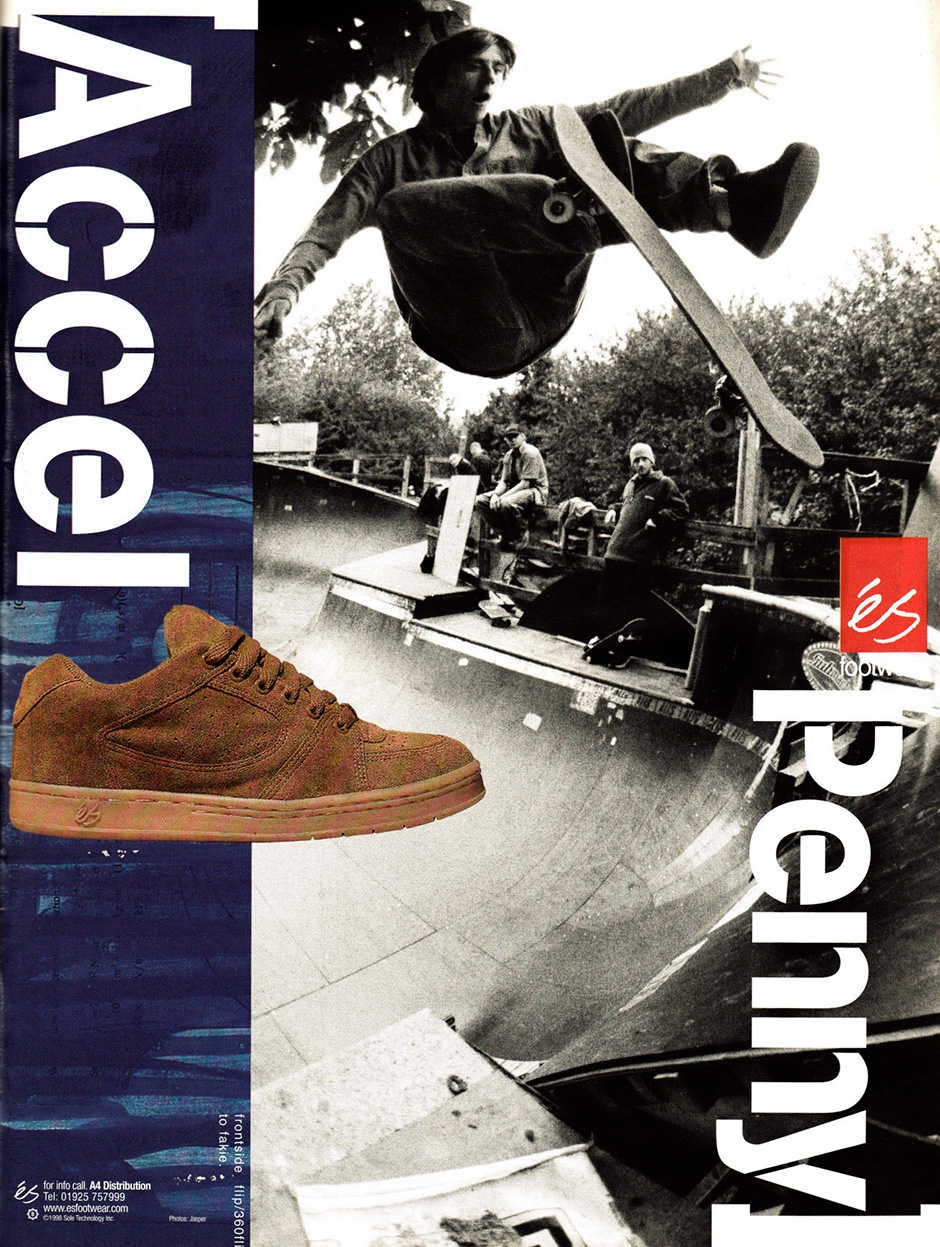
The Koston 1 was a really interesting one. I worked with Eric on that and at the time I was also sort of hooking up Rick Howard with shoes, but Koston was the one who went more with the éS side of things. We actually had a shoe created for Rick Howard a bit later on, but there were a couple of things that didn’t work out, and then DC swooped in and offered him a crazy deal and he went there and basically took that shoe to DC. We have the original drawing from when that was going to be for éS.
So Rick’s first DC shoe was almost actually an éS?
Yeah.
That’s crazy. That’s one of my favourite shoes. DC definitely owe you.
It’s funny, we were talking about it recently because that guy @skateshoedreams did the Rick Howard éS shoe and we were talking about how it might be funny to talk to Mike and Rick and actually do the Rick Howard shoe that never came out.
Original sketches of the Rick Howard éS shoe that never was
That’d be amazing. I was wanting to ask about reissues of pro shoes… Axion exists again for the third time round and whoever they are, they’ve remade Guy Mariano’s shoe but without Guy’s name on it and without any involvement from him. What can you tell me about reissuing past pro models? éS reissued the Scheme, but not the Koston 2.
We own all of the pro shoes 100%. We own the design, and we can do whatever we want with it. We’re just holding back, but we’re definitely looking into that stuff because the demand for that stuff is so high.
To be clear, you could easily reissue the Koston 2 or the MJ 1?
Yeah. At the end of the day, we report to the marketplace. We’ll do what the market wants, and they’ve definitely been crying out for a lot of the reissues. It’s definitely something we’re looking into.
That’s really good to know. Anyway, you were telling me about the Koston 1…
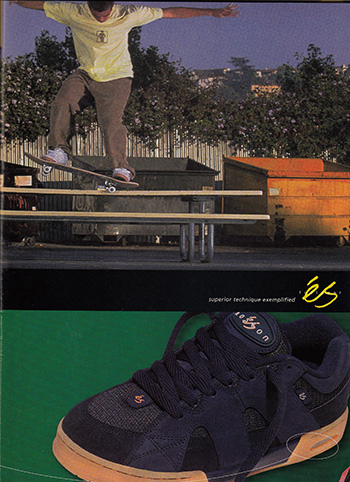 Rick and Eric were really into volleyball-style shoes, or like a Hi-Tec squash shoe. An indoor court shoe with a double cup gum sole that doesn’t mark the court or whatever, then it has suede and it usually has a mesh upper. A lot of the time it’d just be white with a little blue Hi-Tec logo. Eric really liked that kind of shoe. One day, randomly, when we were sketching out ideas for it, a box of shoes turned up. They must have been made at the same factory, but it was the wrong brand. Have you heard of a brand called Troop?
Rick and Eric were really into volleyball-style shoes, or like a Hi-Tec squash shoe. An indoor court shoe with a double cup gum sole that doesn’t mark the court or whatever, then it has suede and it usually has a mesh upper. A lot of the time it’d just be white with a little blue Hi-Tec logo. Eric really liked that kind of shoe. One day, randomly, when we were sketching out ideas for it, a box of shoes turned up. They must have been made at the same factory, but it was the wrong brand. Have you heard of a brand called Troop?
Yeah, big chunky high-tops from back then. LL Cool J wore them. Cheaper than Jordans.
It’s weird because I think Troop was actually bigger in Europe than it was in the US. But yeah, in the late eighties there was the merging of music—hip-hop culture specifically—with footwear. So all these weird brands like Troop and SPX and British Knights popped up which looked like basketball shoes, like Nike or addias, but they weren’t. They were this cultural thing instead, they were about the culture of hip-hop. It was weird because I’d never seen a Troop shoe in the US but I remember them from the UK.
The were absolutely ubiquitous for a couple of years, those and BK. At my school, anyway. Whoever had the chunkiest high-tops was the coolest. Understandably.
Yeah! So basically, this box of Troop samples turned up, and one of the shoes had an ‘E’ on the side. I’m looking at it and thinking how we could take that ‘E’ and put it on the double cup, either with a nubuck or suede surrounding and a mesh inner, so we sketched that up and that’s how that shoe came about. It was kinda luck, again! Being in the right place at the right time when that shoe almost randomly dropped out of the sky when we were looking for inspiration. And then that shoe has become one of the most iconic shoes of that period, and one of the most desired for sure.
So, what about the start of Emerica?
There’s actually another one that you’ve forgot…
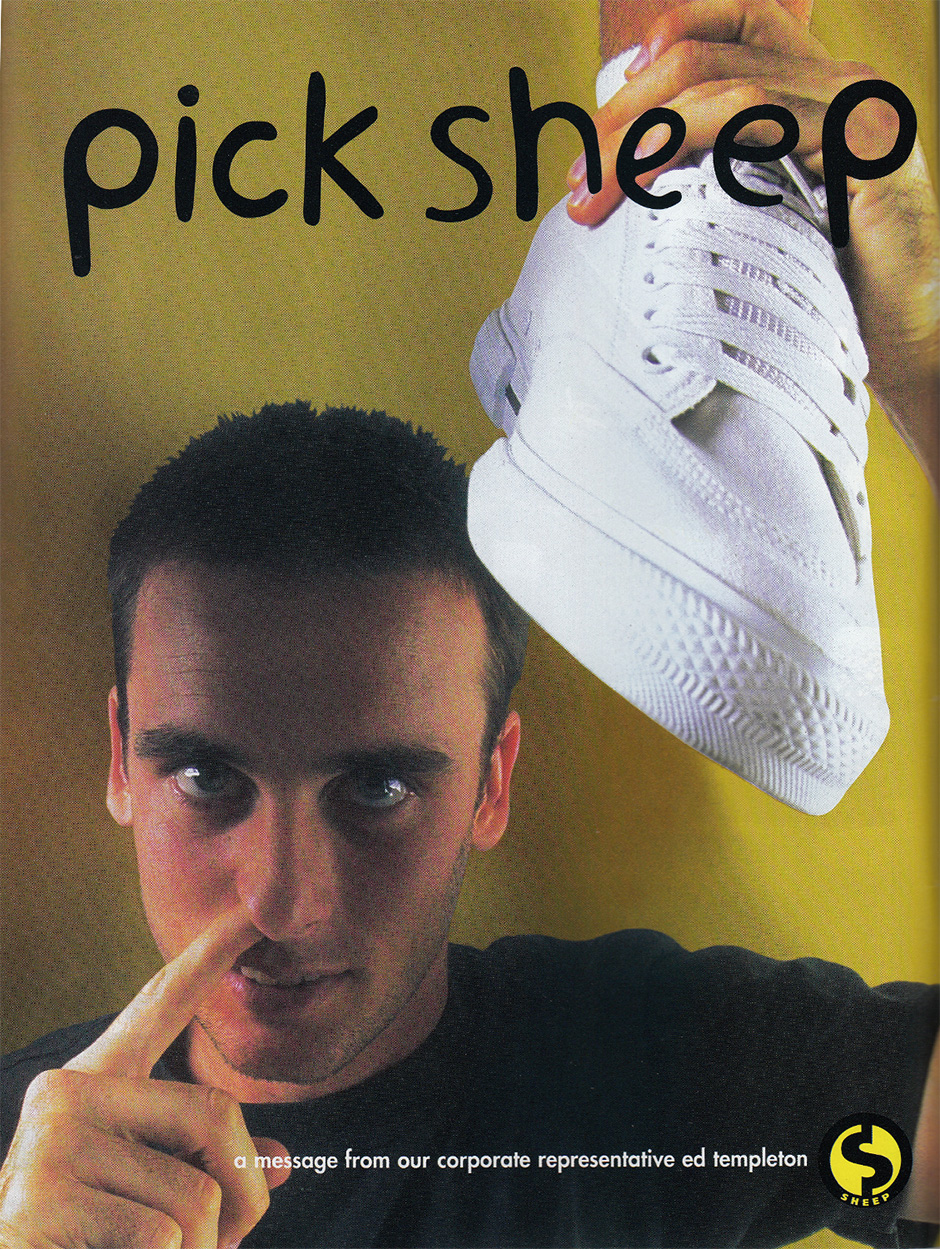
Wasn’t Sheep a few months after Emerica?
It’s funny because there has actually been some dispute about that. I’d always said Emerica was ‘97, but the Emerica brand team kinda changed it to ’96. I’m positive it’s because it just looks better, the numbers ‘1-9-9-6’ look better than the numbers ‘1-9-9-7’. Also though, it depends when you base it off, if it’s when the brand was created or when the brand hits the market.
Ha, cool! I didn’t know when you’d thought up Sheep, only when the shoes and ads appeared.
Exactly, exactly. Sheep was an interesting one. Skate shops have always been our number one priority and they always will be. We had so much demand from people outside of skateboarding wanting to buy our product, big footwear brands wanting to buy our brands. We went to a trade show and saw that Skechers had an identical Sal 23 model, and they had a Jeremy Wray Dukes model.
They did a Vans Jazz rip-off at the same time as that Dukes copy too.
Yeah, and unless you trademark the shoe, it’s really hard to fight that shit. Them having that shoe just reinforced the fact that we should create a brand to rip ourselves off with. We’d just make it cheap, sell to the mainstream, then call it a day.
Right. Like a sacrificial lamb…
Haha! Exactly. Although the name actually came from Pierre, when he was talking to a rep, saying that “We should call it Cheap and Chic!” and sometimes Pierre’s translation of things is a bit off… There was that really awkward silence, so I suggested we call it Sheep, because we were just going to be following everything else and sell it out. So when it became Sheep it kinda moved forward.
We’d always sold canvas shoes cheap, so we made canvas shoes for Sheep, but Pierre hadn’t calculated that the duty on canvas shoes is actually way more than what the suede was… The idea of having a cheap shoe kinda fell apart when the shoes weren’t going to be cheap anymore!
Rick McCrank had come down, I think he was visiting a distributor or whatever, and we ended up working something out with Rick to have Rick on Sheep. Ed Templeton was one of the first people I called because he was someone I’d known forever, and he was riding for Vans at the time, so I asked if he wanted to ride for Sheep and he was super down for it, so that made sense.
Mike Manzoori’s floaty Stalefish centre stage of a Sheep Ad from 1997
Mike Manzoori was a good fit too.
Yeah, I’d been hooking Mike up with etnies for a while already. It wasn’t intended to be a vegan brand, but that’s the thing—when you get your key people and they’re vegan, it’s going to attract every other vegan to want to be a part of it. I think the only person who wasn’t vegan was Brian Anderson, but I think he might have been trying back then. The shoe brand wasn’t even vegan; we had suede shoes and leather shoes in the line for a while.
Frank Hirata wanted in—he rode for us already—and there was Sergei Trudnowski from Philadelphia… This was this super-gnarly crew, and it’s still to this day probably one of the most cult ‘Best Team Ever’ squads. It was just really confusing though, because it wasn’t intended to be a vegan brand, and it became a vegan brand, and it was almost too progressive because nobody at the time was asking for vegan shoes.
Matt Field hopping the fence in Santa Cruz, another element of the ‘Best Team Ever’ squad. Inset Below Left – creative genius Yogi Proctor
That had been attempted before, with Zero Two, which Ed skated for too.
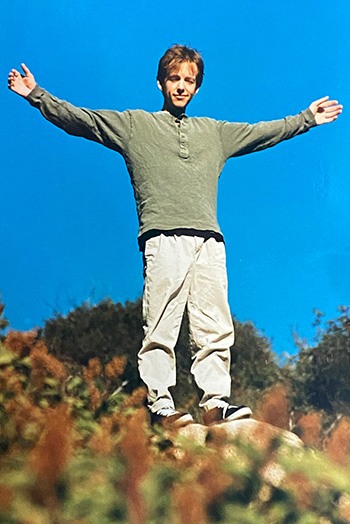 Yep. Another key piece of the Sole Tech story… Alex Wise had gone back to France, so we needed to hire somebody new. Tod Swank had said he had somebody, if we were wanting to hire an art director or a creative director or whatever, and it was Yogi Proctor. So Yogi came down with this little briefcase and showed us some stuff, and he got the job.
Yep. Another key piece of the Sole Tech story… Alex Wise had gone back to France, so we needed to hire somebody new. Tod Swank had said he had somebody, if we were wanting to hire an art director or a creative director or whatever, and it was Yogi Proctor. So Yogi came down with this little briefcase and showed us some stuff, and he got the job.
We had no idea at the time how much of a genius that guy is, and how he thinks twelve layers deeper on everything than everyone else with structure, branding and creativity. Yogi ended up creating all the branding for etnies, Emerica and Sheep. It’s nice to give props to all the English people who’ve been part of it! Obviously Manzoori is one of the best video guys in the world, and Alex Wise is English too, with. A big European influence.
So, Sheep was a really fun brand that just kind of made fun of everything, and itself, and just kinda became vegan. It was at a time when everything was growing so much, and suddenly the French guys say, “Hey, we want to sell the etnies brand”. Pierre and I talked about it, and thought, “Fuck it, we don’t need etnies. We’ve got éS, we’ve got Sheep, we’ve got ThirtyTwo. They’re gonna fail if they try and do it themselves because they have no idea about skateboarding”.
So we abandoned etnies for a season, and transitioned everything into Emerica. The reason it was called Emerica was because when we originally had the US distribution it was called etnies America, so it was an easy transition to take the ‘E’ from ‘etnies’ and put it in front of ‘Emerica’.
Jamie Thomas and Daniel Harold Sturt for Etnies America just before Emerica was born
Was anybody in charge of etnies then? Were the owners just waiting for you to come back to it?
It went back to the French guys. We’d heard that Nike were interested in buying it, but the French guys didn’t want to sell it to Nike because they appreciated what we’d done to it, and the heart and soul we’d put into it.
They eventually offered Pierre a really good deal for the brand, something he couldn’t turn down. We figured we could have etnies do action sports, the whole snow/surf/BMX/motocross thing, with big distribution. That could be etnies and Emerica could be more rock n’ roll, more ‘Fuck The System’, and éS being more athletic/urban/technical/innovative. At the time Sheep was doing its thing, and was a little misguided, but basically vegan and at a little bit of a cheaper price point.
I think with most businesses, it’s about building a brand and then selling it off. That’s what 99% of all business people want to do. But I think these people really felt the passion and the love that Pierre and myself had put into the etnies brand, and it’s really hard to replace that.
I’m sure the company was valued based on the key people working there.
It’s always about the people behind the brand, and without us it wouldn’t be the same. I think they realised that without us it wouldn’t work, so just gave Pierre a good deal.
Cool. So what happened with Sheep?
It came to the point where we had too many brands and not enough people, and everything was still growing, and the market was still going crazy. Sheep was the most challenging one with the least direction at the time, and different countries around the world were kinda struggling with it, so we thought, ‘Fuck it’ and put it on hold for a while so we could focus on etnies, éS and Emerica and get those strategies in the skate side of things working better. So we agreed on that.
Probably about a month before that decision, Ed brought me this big piece of wood that had ‘The sheep will be led to slaughter’ on it, with no idea that we were going to put that brand on hold and shut it down for a while. It was really weird that he did that, with no idea of anything that was coming. We transitioned the brands, and obviously Templeton became a huge part of Emerica, McCrank joined éS, Brian Anderson was snatched up by Savier at the time, Frank Hirata kinda disappeared out there, I can’t remember what happened with Sergei Trudnowski and Manzoori became a bigger part of etnies and took more to do with the video role.
Eric Koston, Tom Penny and Mike Manzoori creating history
And the on Emerica side of things?
We still had a lot of the guys that had just come from etnies onto Emerica, so that Yellow video was a bit of a mess, in terms of who was on the team and who wasn’t. There were a bunch of randoms, people like Dave Mayhew and Chad Fernandez, so it’s just a big pile of skateboarding and you’re watching it going, ‘What the fuck..?’ but it was really random because it was still trying to work its way up.
Justin Regan, who was a sponsored skater from Southern California who had been a friend of mine and Pierre’s forever and was working in sales for us. I transferred him into the role of Team Manager for Emerica. He got put with Heath Kirchart and those two had to go through the whole Emerica team list and just clear out a load of people, and let people know what the deal was. There were a lot of leftovers of the etnies days of just flowing everyone. So it boiled down to another superstar team, at the same time as the Piss Drunx movement, and Baker and all that stuff was starting to grow. It was the perfect timing for a new movement in skateboarding that went away from the athletic side, and more into the rebellious rock n’ roll side.
And Emerica were still tech anyway, like they’d need to be for jumping down Hollywood High.
Exactly.
Was there ever a shoe that got moved from one brand to another? Or a skateboarder who you wanted for one brand who ended up on another one?
It’s funny because a lot of the time with riders, it’s their values and their style that really helps define them. Like Koston is 100% éS. You can base everything you do there on ‘What would Koston want? Would he like this shoe?’, and whether it’s a yes or a no, that leads you in the right direction. There are people who are right in the middle, like I’d say that Erik Ellington is one of the rare people who could be on either side.
It’s Erik I’m thinking of. His first shoe could have easily been an éS.
Exactly, right? And a person like Erik Ellington is very valuable because they can help cross that chasm between the hesh and the fresh. Not that you want to compete, because I think that within a brand portfolio like Sole Tech you want it to be really black and white, to the point where there’s minimal grey because you don’t want to cannibalise. You want a sales guy to be able to go into a shop and go, “This is éS, this is Emerica, this is etnies” and not have the shop go, “Well, we’ve already basically got the éS version of that…” so it’s got to be very differentiated and defined.

Reynolds loved the Accels, before Emerica, so on his shoe drawing, everything references an éS Accel. The Reynolds 1 is really based off of an Accel. When those things come in, that’s when it gets challenging. When a rider comes in and doesn’t know what they want in a shoe, but just wants what all their friends are wearing, it can take you down a sketchy rabbit-hole of making something too close to what the competition’s making. Because you don’t want to be doing that. Or you don’t want to make something that looks too much like something we already have in the line. Each brand has to be as differentiated as possible.
Was it because of the vulc shoe trend that you put éS on hiatus when you did?
Yeah, there’s definitely something to that. To put the time in perspective, in 1999 we had etnies, éS and Emerica, and my focus was on putting the etnies brand into wider distribution. So out here it’s Pac-Sun and over there it’s Schuh or Size? or whatever, but we have to reach those eyeballs, right? At that point the X-Games was blowing up and they were reaching more than 300 million households on TV—this was all before social media—so the goal was to figure out how to find top riders who’d be placing on the podium or getting TV exposure on the X-Games wearing the etnies logo, so that when that mainstream person is having a drink at the bar and looks up at TV and sees skating, they see the big etnies logo. So, then they think skating’s cool and they want to buy their kids some shoes, so they go to their mainstream store and see the logo they recognised from the X-Games and know it’s a skate shoe and they buy it. That was the general strategy, and it worked. We had a lot of the contest skaters on the team at that time.
With éS, it was a very specific sort of vibe and we kept it to skate shops only. In hindsight some people would say that that was a big mistake for us, because éS had the best skate team, possibly even ever… And we had the easiest path to sell out to the masses, but we didn’t.
Best team ever indeed. Ronnie Creager with a Switch Front Shuv in this ad from ’97
I wouldn’t argue with that.
And when you have that it’s almost an opportunity to expand and make way more money because the core is always going to have to support you because your team is so amazing. The skate shops are still going to buy it. But we sold purely to skate shops and never had this gigantic reach. We’ve always really kept it within the circles of skateboarding. There’s been a few things here and there where we’ve been in Schuh or Size? but it’s never been a big thing for us. It’s always been about the core skate shops. It’s the same with Emerica, that’s 100% skate.
etnies Snow came about while ThirtyTwo existed. Is snow a big enough market for you that it needs two Sole Tech brands? Do you have fresh versus hesh in snowboarding too?
ThirtyTwo makes the snowboard boots, and etnies do the after-riding stuff, the weatherised shoes. Skateboarding drives the core essence of action sports culture. Snowboarders look at skateboarders for influence, BMXers are all skate nerds who look at skateboarding for their influence in fashion direction, in surfing it’s a little bit different because some guys do, and some guys don’t. Motocross is kind of in its own little world.
When we first launched etnies it was all about skateboarding, but then people like Jeremy Wray would come in and go, “Hey, I’ve got this guy you have to check out, this BMX kid that I ride with all the time”. So if it’s Jeremy Wray telling you that you have to check a video out? That guy was Mike Escamilla, and he’s rad and he hangs out with skateboarders, so we started hooking up Mike. Then Mike goes out there and gets footage, he does his thing, then before we know it every single top BMXer in the world is hitting us up, wanting to be a part of etnies. So the BMX side gradually grew, organically.
There was a big culture of snowboarding in Orange County and it was the same thing with our snow program. Burton didn’t make shoes, so all the Burton riders would be hitting us up, all the top guys, so before we know it, we’re hooking up all the snowboard guys. None of it was planned, we never sat there like, “Let’s penetrate the surf and snow industry!”, it was more that we were just a bunch of fuckin’ skateboarders hooking up our friends.
And if some dude on some snowboard company wants to chill in your shoes instead, bring it on.
100%. We even did pro shoes for some of those guys, and at one point the moto program was 50% of etnies’ business but we’ve always been able to take the money from those sales and put it into building skateparks and doing stuff for shops and paying our skate team more. We were definitely paying our skaters more than any other brand at that time, and it all came from that mainstream money. It was a healthy ecosystem of taking from the mainstream and giving back to the core.
We were definitely paying our skaters more than any other brand at that time, and it all came from that mainstream money. It was a healthy ecosystem of taking from the mainstream and giving back to the core
Well, speaking of reinvesting money, there’s the Sole Tech lab. What goes on in there?
As we were growing so much in the 2000s, we realised we had to go back to the fundamentals of why we started this, and what we love about it. Giving back to skateboarding was a given with all the events and sponsoring riders, but we knew we had to be making sure we were making the best shoes for skateboarding. Our foundations were all about making the best shoes for skateboarding.
Pierre basically hired some guys from MIT, these biomechanical and engineering guys, from out on the East Coast. One of those guys had worked for Nike, and some other brands, for a number of years so had all this knowledge about all the testing that can be done.
We set this space up, this 10,000 square foot training lab. A skatepark with hydraulic stairs that can go from a five-stair to an eight-stair and a pressure plate at the bottom to measure the impact. There were 360-degree lights, like when they make video games and put the little black balls on you…
The ping pong balls.
Yeah. Sheckler was the test rat most of the time, so you hook it up to the screen and see what’s going in with the forces on the body. And you’d find out stuff, like learning that the force of jumping off an eight-stair is equal to seventeen times your body weight. When you think that most kids are doing that hundreds of times a day, maybe thousands of times a month, with the feet being the first point of contact—hopefully—you know that you need to have a strong foundation of impact resistance and comfort in the shoe. That was always a big focus.
Air systems too. Air systems are comfortable but the impact going down on it from landing pushes the air bubble all the way down so you’re still getting the impact from landing and heel bruises and all that stuff. So, we explored more of a gel system, the G2 O2 technologies, which really help absorb the impact from big jumps. We’ve transitioned that more into different foam technologies over the years; Emerica has the G6, etnies has the Evolution Foam and éS has the Energy Foam.
The lab also had abrasion testing machines, flexometers to test the flex of shoes and all this other really amazing stuff. It was the first in skateboarding and it was a great learning experience to have that.
How do you develop foam? Do you find somebody who manufactures foam and then ask them to change it?
Yeah, it’s really just working with the factories in Asia. We still have a testing lab there, and that’s where we do all the testing now. We learned so much from doing all the testing at the beginning, and it’s good to have that knowledge going forward.
Chad Muska’s game changing shoe even showed up on the SD police force radar
Did you think the Muska shoe would be the shoe that introduced hundred-buck skate shoes as the standard?
When we were like, “Fuck, we’re breaking the hundred-dollar barrier”, it was the first time for a skate shoe, and it was scary. We weren’t sure if it was going to work. I didn’t know. But the first Koston shoe…. I want to say it was $45 for the double-cup without the airbag, and then we had the blue/gum that was $47… It was around those prices anyway.
Wholesale.
Yeah. That was keystone so when it hit the market it was $90 and $95 or whatever. I think the Muska shoe was $52 wholesale, which ended up at $105 and not one of us knew if it would work because nobody had gone across that barrier. But sure enough when it hit the market it sold out. I talked to a guy at Pacific Drive down in San Diego—that was a huge shop back in the day for skate culture, that was the shop—and he told me how they’d have UPS trucks delivering every day, but one time a UPS truck turned up and the whole thing was Muska shoes, which all then sold out in a day. It was crazy.
And it had the stash pocket.
It made sense for Muska with his weed-smoking vibes, it made sense to have a little stash pocket. But the police in San Diego were actually pulling skateboarders over and checking their shoes. They didn’t know if it was a Muska shoe or not, but every skateboarder in San Diego that got pulled over was getting their shoes checked.
In March 2002 you ran an eighteen-page ad in Transworld.
Hahaha! Back then nothing was impossible. It wasn’t just us though, by that time other brands had started growing, whether it’s Globe or DVS or whatever. The funny thing is that Globe ripped off the etnies Screw, which was one of our top-selling mid-top shoes. They took our top-selling shoe in Australia, ripped it off, put ‘Globe’ on it and they started crushing it there. They started Globe off the etnies Screw.
With DVS, the first Daewon shoe was ripped off of an etnies Cyprus and that shoe really helped launch DVS. We made the first DC shoes, so we helped create those guys… Haha! We helped launch so many other shoe brands. Just not on purpose.
We helped launch so many other shoe brands. Just not on purpose
I guess it’s the same as when you guys were looking at what skateboarders were wearing, and then making your own version of it. It’s just that it’s skate shoe companies taking ideas from other skate shoe companies now.
Exactly. At the time everyone was borrowing from each other and no-one cared. It was chaos and we were all friends, and we’d all hang out. If there’s a DC party, I’m there and I’m stealing all the drink tickets. We’re all just skateboarders having a good time.
Freestyle conspiracy in Oceanside. Don does a Handstand three sixty flip for J.Grant Brittain in 1989
What are your thoughts on how freestylers run so much of skateboarding?
There was always talk about the Freestyle Conspiracy, and I don’t know why or how, but it seriously was the case that freestylers pretty much owned all the biggest parts of skateboarding. You’ve got Rocco who owned World Industries and Big Brother with Rodney Mullen there too, obviously me and Pierre doing the Sole Tech thing, Per Welinder, Reggie Barnes being the biggest distributor on the East Coast, Kevin Harris up in Canada, Jean Marc [Vaissette] in France, Christian Seewaldt and Jörg Ludewig in Germany doing Urban Supplies, Hans Lindgren doing distribution in Scandinavia, Marco Contati doing distribution in Italy…
There’s more but it was crazy. All of these freestylers kind of owned the skateboard industry, in a way. None of them were the most powerful individuals within the industry at the time, so no-one really knew why. There’s even Paul Sunman with Slam.
Do you think it’s just something in the mind of freestylers that lends itself more to procedure and business?
I think there’s definitely something to that. Everyone thought that street skating was more spontaneous, it was about going out there and hitting spots, but with freestyle you actually have to plan it out.
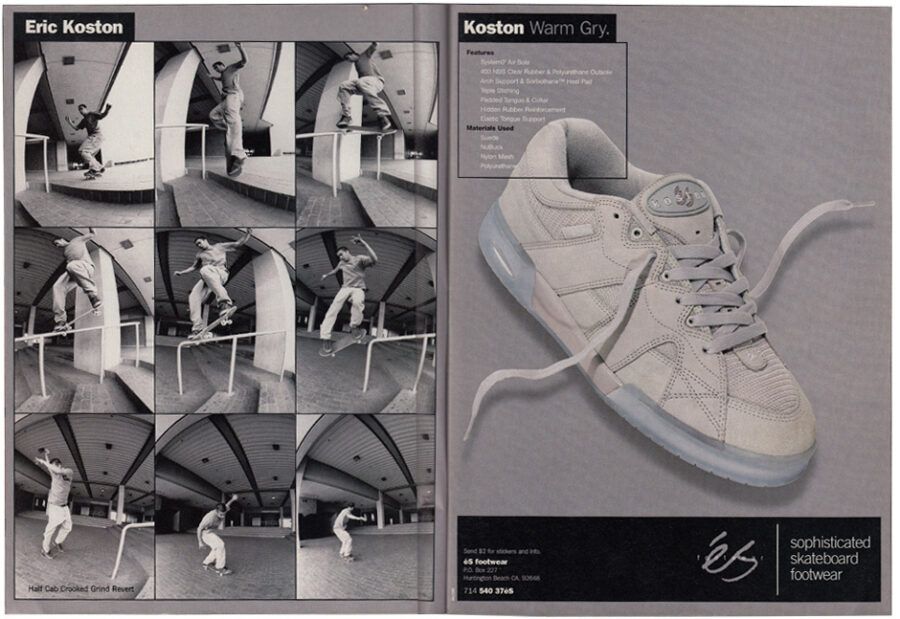
What’s your favourite shoe from each brand? If you absolutely had to pick. Which you do.
Wow. Hmm. I think for éS it would be the Koston 1 because it was pretty unique at the time and something I helped design much of. There wasn’t anything that looked anything like it at the time, and there were so many different colour opportunities on that shoe to the point where it can kinda live forever. Obviously with it being associated with Eric too, the best skateboarder ever. Or at least right up there. With Penny.
Good save.
Haha! I’d probably go more with Penny. So, the Koston 1 for éS but also within éS I’d probably say the Accel because it’s been in the line since day one. It’s the one shoe that’s been there forever and every top skateboarder who appeared in the nineties has worn that shoe. So you know, we created an Accel Day on 5/19, which will be all about celebrating the Accel.
And what’s the 19th of May got to do with it?
Haha! “What the fuck?” The five is the letter ‘E’ and nineteen is the letter ‘S’.
Of course. Do you want to eventually just claim every day of the year?
I know, right? Haha! So those two shoes for éS, then for Emerica I think the Marc Johnson shoe was one of my favourites to skate and I actually preferred it to the Koston. It had a little bit more board feel for me; it was a bit thinner than the Koston. I really like the Reynolds 1 too, but probably the Marc Johnson 1. Chris Senn’s shoe was a really good shoe to skate, but aesthetically wasn’t my favourite. I liked the Templeton but it was a little clunky for me. For my personal taste.
 Your favourite etnies?
Your favourite etnies?
My favourite etnies is the Rap. I’ll say the Lo-Cut too, because I helped with initial concept of having the ‘E’ on the side, as much as it became Pierre’s design project because he rounded off all the corners and kinda finalised it. That shoe and the Lo-Cut 2 and the Cali-Cut paid for a lot of drinks at the bar. They paid for a lot of skateboarders and they paid for a lot of things to get done because we sold so many of those shoes to the mainstream, and we reinvested that money back into skateboarding.
How much stuff did sales of the Fader and Calicut pay for? And where do you moor your yacht?
Haha! Shit. I wish I had a yacht. That shoe just sold… They were definitely the top selling shoes in the era. They outsold everyone else. Vans didn’t really turn up for the show in the nineties and were somewhat irrelevant. They had off-trend shoes and they were trying to be someone that they weren’t, and it wasn’t until the early 2000s or so that they found Geoff Rowley, and the Era or whatever. And then their position was seventies skateboarding and Tony Alva and pool skating and Californian culture and that’s when they started growing again.
Nobody really needed the Caballero 8. Not when Half Cabs exist. What about your favourite Sole Tech video? High 5 is kinda perfect.
I’d say High-5 definitely, because it was the first video that any shoe brand had ever done. It was always board brand videos, so it was the ability to cross multiple riders and put the best of the best in one, versus having one skate team. There were multiple hardgoods teamriders in one video. Tom Penny’s part in that is still one of the best parts ever.
The chain…
Tom Penny is, to me, the number one. Obviously today, Tom is not where he was, but in his era, he was twenty times beyond every top pro street skater at the time. He was unbelievable. To see him in that was just totally ridiculous.
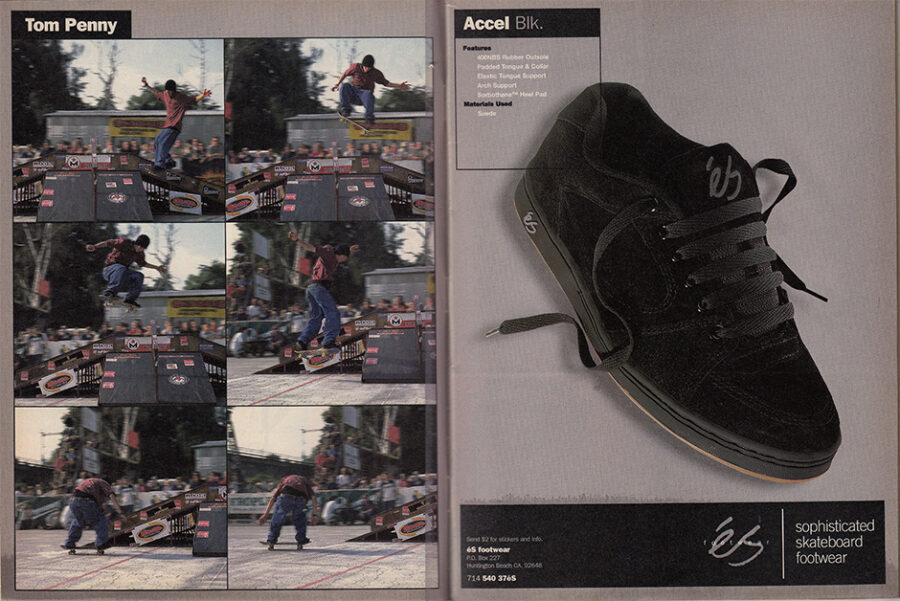
Who has been good at helping design a shoe, and who didn’t really care? We know about Tom sending you the Columbia hiking boot, but what else?
Eric Koston definitely knows what he wants, and Chad Muska knows what he wants. I think McCrank and Creager weren’t so much on the tip as far as what’s going on in fashion so they’d be more like, ‘Tell me what you feel I should have’.
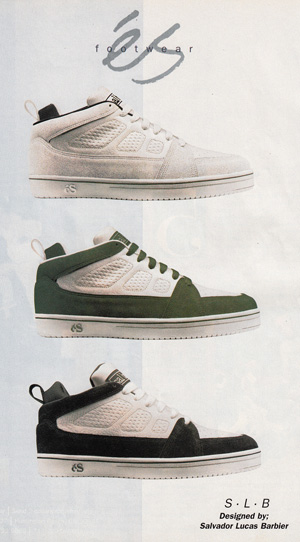 Jamie Thomas was definitely someone who was very particular about what he wanted which was amazing. I think Reynolds was too but based on the other shoes that were out there. Ed wasn’t too clear on it, it was just general ideas that boiled down into what made sense for him. Sal Barbier was really good, obviously. This is all more from the beginning, and the guys I actually worked with.
Jamie Thomas was definitely someone who was very particular about what he wanted which was amazing. I think Reynolds was too but based on the other shoes that were out there. Ed wasn’t too clear on it, it was just general ideas that boiled down into what made sense for him. Sal Barbier was really good, obviously. This is all more from the beginning, and the guys I actually worked with.
You shouldn’t really expect somebody who’s spent their whole life getting really good at skateboarding to suddenly know how shoes are designed.
That’s the thing, but when you break down people like Sal, Koston, Muska and Jamie they’re all people who are very aware; they’re always looking at what’s happening out there outside of skateboarding, what general trends apply to their lifestyle that they could bring in and make skateable. What things can be tweaked.
So pros generally appreciate how sellable a shoe has to be? It’s not like when Homer Simpson designs the car?
Some people. Not everyone. Some people are just like, ‘I don’t give a fuck, I just want my name on a pro shoe!’ and then others are more kinda looking at what else is going on out there, and really thinking about how they want to build the shoe.
Now that skateboarding is middle-aged, do you think we’ll get to the point where former pros still have shoes out, like how you can still buy Jordans? Or Chuck Taylors or Stan Smiths for that matter.
It’s kind of weird because I feel like the nineties was a very special time for skateboarding. With the Natas shoe coming out first for etnies in ’87, and then a year or so later the Vans Cab, those were the early-adopters of skate shoes. Then in that nineties period we did the Sal Barbier shoe, and the rad thing about that is that Sal was actually the first black skateboarder to have a pro shoe. So there were legends created back then, and I feel like it’s going to be hard for people to get to that status again, for some reason.
It feels like all that was the beginning of the next level of one of the gnarliest progressions of skateboarding. In ability and innovation, but also in style and fashion.
Sal Barbier’s third pro shoe – the SLB 97
I think stuff from then is so memorable because there wasn’t as much of it, we were seeing things for the first time and it took effort to dress well so stylishness stood out more.
Yeah, and you live in this world more than anyone, you and Kevin [Marks, @lookbacklibrary] but there was a point in the nineties when it was just magazines. You’d have a choice of three, maybe four, magazines and as a skateboarder that was the way you saw skateboarding, and you could pretty much memorise what you were seeing and you could fan out thinking about what that trick really looked like in real life. A lot of times a photo can make you into a hero so much more than a video that comes and goes. Things can just look so much better in a photo, I guess. There’s so much unknown.
Muska, Koston and Penny… Those guys grew up in this world of magazines and they were getting on the covers. Jamie Thomas was the master of that, I remember him telling me, “I’m going to get an interview in Transworld, I’m going to get the cover, I’m going to get a double-page Emerica ad, I’m going to get a CCS ad, I’m going to get a Zero ad, I’m going to get a whatever-the-fuck the truck company was at the time ad” and he’d have it all planned out.
So, you’d pick up that Transworld and you’d start it with Jamie, end it with Jamie and it was Jamie in the middle. Taking over the airwaves. That’s the way you do it, and that became normal. If Koston has the cover, an interview, an éS ad and a Girl ad, when you put the mag down all you can think of is Koston. And those mags got etched into the minds of a generation.
Today I see the most amazing skateboarding I’ve ever seen, ten times a day. From people who I have no idea about.
Jamie Thomas with a bare foot double page ad for Emerica in 1997
And you double-tap and move on. Rather than tearing the page out and sticking it on your wall where you can see it every single day when you fall asleep and then again when you wake up.
Exactly, right? I don’t know how you can quantify what’s required for somebody to get a pro shoes these days. Those guys in the nineties just had legendary status, and that’s really hard to replicate in today’s world.
There’s Nyjah. With what he does and how he does it, he’s the best skateboarder in the world and he deserves to have his own pro shoe which will sell shitloads because he’s got so much reach and people love him.
Then there’s the people underneath him, like Paul Rodriguez. He’s one of the best humans ever and one of the gnarliest skaters ever, but how many shoes has he had? Ten? He’s had ten shoes or something and not one has become ‘iconic’.
His first one was good but the subsequent nine probably weren’t necessary.
Yeah. And then you’ve got Janoski who’s not on the same level as these other guys, but he’s got charisma and personality and is just a rad human being. No-one would have expected for him to have the success that he did with that shoe, but he did because he hit the right trend at the right time and he’s become this legendary, almost mythical, figure because no-one really sees him, but he’s got the best-selling skate shoe of all time.
But nobody’s buying that shoe because Stefan’s a good dude. Or because of his Habitat parts, for that matter.
It’s weird today; the pro shoe thing is crazy!
Years ago, Vans claimed in an ad that Steve Caballero’s shoe was the first pro skate shoe.
I’ve talked to Cab about this, and he says the Natas shoe was first. That’s all the reinforcement I need, the fact that he said that.
There was a Yeezy that looked a lot like an éS shoe. What’s your take on that sort of stuff?
I personally love it. It’s hard to not sound arrogant and elitist but skateboarding as a whole is this group of people who feel like we can do whatever the fuck we want, and that’s what’s good about it because we kinda do, in a way. Haha! Constantly breaking the rules and just doing whatever we want.
We’ve definitely borrowed a lot of inspiration from other brands, whether it’s fashion brands or athletic brands or whatever. We’ve all borrowed so in some way these people helped pave the path for a certain style, and what we do is like an ode to them in a way, but the fact that it’s all gone three-sixty now that fashion brands are coming and blatantly taking what we’ve created, it’s all good. It shouldn’t be anything to be angry about, but we get tagged in posts by other brands, people going, “Fuck these guys, they’re ripping you off!”
There’s a Stephen Curry brand right now—the basketball player—for Under Armor and I don’t know if you’ve seen it, but the logo is just like the éS logo. It’s very similar and we get tagged all day long with people going, “What the fuck! Sue these motherfuckers!” but it’s just kinda what it is. You can’t really do anything. Us fighting a multi-billion-dollar brand would put us out of business paying for lawyers, so it just is what it is.
Yeezy Inspo? Futuristic silhouettes from 1998. Rick McCrank Frontside noseslides in the Koston 1 While advertising the recently re-issued Quattro
It doesn’t really stop you doing what you’re doing.
I take it as a compliment. I definitely get hyped. It’s a bigger-picture discussion with fashion I think, because when you look at Louis Vuitton and Gucci—yeah, they’re desirable brands—but I feel they got pigeon-holed into this older, affluent segment of the market. And they’re all old now, and they’re dying off. All these people who grew up with these luxury brands are old now, and they’re all sitting around with their expensive bags and their Rolls Royces or whatever, and they’re dying off.
Meanwhile hip-hop and street culture has found itself in a place where it wants to be more luxury, and then you’ve got Supreme who cross that chasm like a luxury streetwear brand, so it makes sense that bigger fashion brands want a piece of that to be able to connect with the younger generation. They’re seeing that this young sneakerhead community is paying thousands of dollars for shoes, so if those kids have thousands of dollars, they’re also going to spend thousands of dollars on a handbag for their wife, or for themselves. Then Virgil came in and it feels like there’s someone who understands the skate culture there now.
Everything goes in cycles anyway, and they’re all kinda looking at each other trying to figure out what the next thing is going to be. It’s the same as when you watch the waves of skateboarding.
When the Yeezy shoe came out that looked like an éS, everyone started talking about skateboarding and suddenly before you know it every ad in Vogue magazine has a picture of a skateboarder, and then every other fashion brand realises they have to get into skateboarding, and they all do their own version of skateboarding. Louis Vuitton were lucky enough to latch onto Virgil, who can do it somewhat legitimately when he gets Shiloh’s name correct.
I think overall it’s interesting, again, to see this rebellious counter-culture thing be embraced by all these people that no-one ever wanted it to be embraced by. This thing that no-one ever thought would happen. No one ever thought Louis Vuitton would want to get involved in skating, ever.
Another thing within that; I’d come up with the concept of Go Skateboarding Day a long time ago, and through IASC [International Association of Skateboard Companies] I was able to make that happen, but the thing that was in my mind for doing that day was to create a focal point for people to get behind. Specifically, media, so we could communicate to mass media that there’s a thing called Go Skateboarding Day. It’s in June, and a lot of the media are looking for something to do for editorial. Vogue actually did the whole month of June dedicated to skateboarding, which I believe helped create this amount of attention on skateboarding from all these luxury brands to the point where they’re realising that skateboarding is really good and has this really culturally diverse, interesting group of people that are often very good looking. And they want to be a part of that.
Don Brown launched Go Skateboarding Day as a Holiday in 2004. Here he is skating against the grain in Orange County to promote it in 2011. Photo: Skin Phillips.
And at the other end of things, you give out shoes to homeless people at Christmas, right?
We do it for the LA Mission every Easter. It’s been 23 years now that we’ve been giving shoes to the homeless. We do it every year and we do it on Good Friday, the last weekday before Easter. It’s really good, it’s a Pierre initiative to just give back.
In the early days me and Pierre were living on the streets. We weren’t homeless because we had our families back home, but we were sleeping on streets, beaches and couches. Just floating, living a dream, for the sake of being able to skateboard, but you get the feeling of how it could be, much as we’ve never been down the same routes as many of the homeless people out there have been. We’re good friends with the LA Mission, we did it once and it became a thing. I know we’ve given over 50,000 shoes to the homeless now.
We always get the comments saying, “Why aren’t you giving back to skateboarding?!” and it’s true but we already do a lot for skateboarding and we just want to help with the bigger picture, beyond that. When we’re doing this stuff, we’re showcasing to the greater community that skateboarders care beyond their own core group. They care about their community.
The wellbeing of someone who’s likely to get tetanus from standing on a rusty nail is more important than the wellbeing of someone whose kickflips feel a bit weird just now.
Exactly. A lot of homeless people spend a lot of their time on their feet, walking from spot to spot or whatever it is. Having comfortable, durable shoes is important.
The thing that’s really cool about it is that each time we do it we invite riders to come help out, and you can see it become much more meaningful to them when they feel like they can give back in a different way.
It’s quite a religious thing, with the Mission—not that Pierre and I are religious in any way—and there’s the feet-washing thing… They wash homeless people’s feet sometimes and at first, it’s a bit, “Oh shit, that’s crazy”, but when you do it it’s this real release. It feels like you’re giving back and it’s a very humbling thing.
There’s a lot of those kind of things that we do without telling anyone, just to be able to get the community together and give something back. In business the growing thing and the making money thing is almost easy, the hard part is knowing what you’ll leave behind, and what you’re really doing to make a difference. The environmental side of things is a big deal for Sole Tech too.
‘Buy a shoe, plant a tree’.
Yeah. We’ve planted over two million trees, our buildings are powered by solar power and we’ve got all these water-saving initiatives and recycling programs. The bigger you get, the more you have to find ways to give back.
What’s coming up for you this year?
There’s really good momentum right now. Talking about the cycles of skateboarding like we were earlier, I believe we’re in that ’91 moment again, where the community is recorrecting with a new generation of kids that’s going to be coming in and just fuckin’ blowing shit up.
We’ve got an older generation that’s coming in too. The fastest growing segment of skateboarding in the US just now is 35 years-old and older. What we’re seeing is a lot of parents bring their kids in to buy a skateboard, and while they’re there, they’re thinking, “Shit, I used to skate. I’ll buy one too, and cruise around the neighbourhood with my kids!”
Then the youngest group, age six to 13, is the actual biggest segment of skateboarding. The fact that so many six-to-13-year-olds are holding skateboards right now and just doing their thing, leads to an amazing future.
Another thing is that the diversity of skateboarding has just been opened up, through all the conversation on a global level. It’s rad to see. Skateboarding is blind to a lot of the prejudices that a lot of sports have, because it doesn’t matter what colour you are or what your gender is, or what limitations you may have as a human being. If you’re a skateboarder, you’re one of us. The LGBTQ+ thing popping off with brands is just amazing. Skateboarding gives so many different types of people a thrill in their life, an excitement that they could probably never find anywhere else.
it doesn’t matter what colour you are or what your gender is, or what limitations you may have as a human being. If you’re a skateboarder, you’re one of us
It’s not a load of guys in their twenties telling a load of guys in their teens what’s up anymore. It’s everybody now.
When it was dictated by the Big Five in the eighties, it was very much, ‘This is what skateboarding is and this is what you need to do’. The nineties was when we realised skateboarders needed to run the industry and now today, it’s not about the industry, it’s about the kids out there. It’s up to them to dictate what the industry does for them, create their own industry and do what the fuck they want.
Obviously, the Olympics thing has been floating for a while, but it’s bringing so much energy, globally, to where there are countries all over the world who now recognise skateboarding as a legit thing and they’re building parks and they’re building communities. There’s going to be more things to skate and a much better understanding of skateboarding and the culture of skateboarding.
The girls’ market is flying through the roof right now, in general. Girls’ skateboarding is going off and I still believe that at some point a girl is going to be the best skateboarder in the world.
I feel that skateboarding is in the most amazing place that it’s ever been and it’s a beautiful thing to see, after being part of this movement—this journey—for so many years and being able to witness it. Seeing this swell of where it’s come from and where it’s going.
From a Sole Tech standpoint, business is crushing it right now. Our sales are really good, and doing the pre-books for going into next year, our bookings are up in triple digits more than they’ve ever been before.
I think Nike and adidas have done a great job of coming in and taking care of paying people who probably wouldn’t have got paid otherwise, but there’s also the reality of the percentage of what they pay their riders versus what we were paying our riders when we were at the top of the game. We were paying a much bigger percentage to the riders and did way more for skateboarding than they have, based on the scale and the size of their brands. It’s pretty easy to be a mainstream brand and come in and just buy everything up, but now you see the longer-term plan, where skateboarding is not where they’ll get their growth from. I don’t think they’re ever going to get out of skateboarding, but I think they’ll cut back.
At the end of the day, I don’t care what a skate shop sells, as long as they’re still in business and they’re selling skateboards and servicing the skateboard community. As long as you’re there for skateboarding. That’s the main thing.
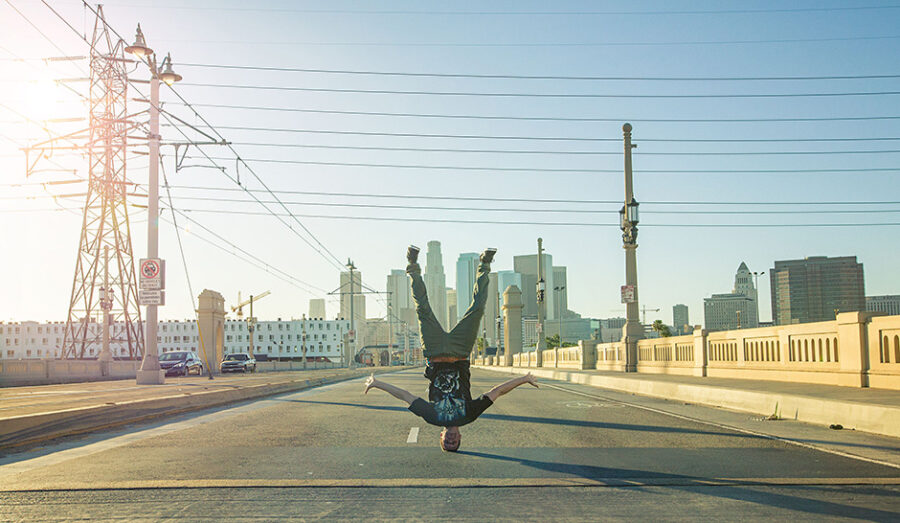
Thanks to Don for taking time out of his busy schedule and for working alongside us for many years. Be sure to check out the latest shoes from éS . All Scans courtesy of @Scienceversuslife and all additional photos from Don’s collection.
Previous interviews by Neil Macdonald: Jeremy Elkin / Steve Kane / Pete Thompson / Tobin Yelland / Carl Shipman / Corey Duffel / Eli Morgan Gesner / Jeff Pang / Sam Ashley



